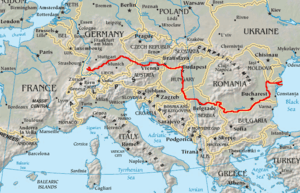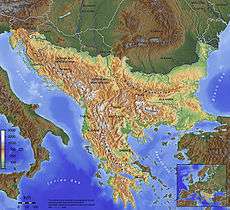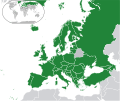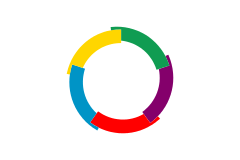Serbia
Serbia (Serbian: Србија, romanized: Srbija, pronounced [sř̩bija]),[note 1] officially the Republic of Serbia (Serbian: Република Србија, romanized: Republika Srbija, pronounced [repǔblika sř̩bija]), is a landlocked country situated at the crossroads of Central[6] and Southeast Europe in the southern Pannonian Plain and the central Balkans.[7] It borders Hungary to the north, Romania to the northeast, Bulgaria to the southeast, North Macedonia to the south, Croatia and Bosnia and Herzegovina to the west, and Montenegro to the southwest. The country claims a border with Albania through the disputed territory of Kosovo.[a] Serbia's population numbers approximately seven million[8] without Kosovo or 8.8 million if the territory is included. Its capital, Belgrade, ranks among the largest and oldest citiеs in southeastern Europe.[9]
Republic of Serbia | |
|---|---|
.svg.png) 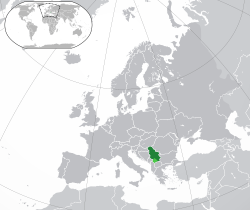 Location of Serbia (green) and the disputed territory of Kosovo (light green) in Europe (dark grey). | |
| Capital and largest city | Belgrade 44°48′N 20°28′E |
| Official languages | Serbian |
| Recognised regional or minority languages | |
| Ethnic groups (2011) |
|
| Religion (2011) |
|
| Demonym(s) | Serbian |
| Government | Unitary dominant-party parliamentary constitutional republic |
| Aleksandar Vučić | |
| Ana Brnabić | |
| Smilja Tišma (acting) | |
| Legislature | National Assembly |
| Establishment history | |
| 8th century | |
| 1217/1346 | |
| 1459–1556 | |
| 1804 | |
| 1815 | |
| 1878 | |
| 1918 | |
| 1991–1992 | |
• Independent republic | 5 June 2006 |
| Area | |
• Including Kosovo | 88,361 km2 (34,116 sq mi) (111th) |
• Excluding Kosovo | 77,474 km2 (29,913 sq mi)[1] |
| Population | |
• 2019 estimate | |
• Density | 89/km2 (230.5/sq mi) (95th) |
| GDP (PPP) | 2020 estimate |
• Total | |
• Per capita | |
| GDP (nominal) | 2020 estimate |
• Total | |
• Per capita | |
| Gini (2018) | medium |
| HDI (2018) | high · 63rd |
| Currency | Serbian dinar (RSD) |
| Time zone | UTC+1 (CET) |
| UTC+2 (CEST) | |
| Driving side | right |
| Calling code | +381 |
| ISO 3166 code | RS |
| Internet TLD | |
| |
Inhabited since the Paleolithic Age, the territory of modern-day Serbia faced Slavic migrations to Southeastern Europe in the 6th century, establishing several regional states in the early Middle Ages at times recognised as tributaries to the Byzantine, Frankish and Hungarian kingdoms. The Serbian Kingdom obtained recognition by the Holy See and Constantinople in 1217, reaching its territorial apex in 1346 as the relatively short-lived Serbian Empire. By the mid-16th century, the Ottomans annexed the entirety of modern-day Serbia; their rule was at times interrupted by the Habsburg Empire, which began expanding towards Central Serbia from the end of the 17th century while maintaining a foothold in Vojvodina. In the early 19th century, the Serbian Revolution established the nation-state as the region's first constitutional monarchy, which subsequently expanded its territory.[10] Following disastrous casualties in World War I, and the subsequent unification of the former Habsburg crownland of Vojvodina (and other lands) with Serbia, the country co-founded Yugoslavia with other South Slavic nations, which would exist in various political formations until the Yugoslav Wars of the 1990s. During the breakup of Yugoslavia, Serbia formed a union with Montenegro,[11] which was peacefully dissolved in 2006, restoring Serbia's independence as a sovereign state for the first time since 1918.[12] In 2008, the parliament of the province of Kosovo unilaterally declared independence, with mixed responses from the international community. Serbia is one of the European countries with high numbers of registered national minorities, while the Autonomous Province of Vojvodina is recognizable for its multi-ethnic and multi-cultural identity.[13][14][15]
A unitary parliamentary constitutional republic, Serbia is a member of the UN, CoE, OSCE, PfP, BSEC, CEFTA, and is acceding to the WTO.[16] Since 2014, the country has been negotiating its EU accession with the perspective of joining the European Union by 2025.[17] Since 2007, Serbia formally adheres to the policy of military neutrality. The country provides social security, universal health care system, and a free primary and secondary education to its citizens. An upper-middle-income economy[18] with a dominant service sector, the country ranks relatively high on the Human Development Index (63rd)[19] and Social Progress Index (45th)[20] as well as the Global Peace Index (50th).[21]
Etymology
The origin of the name Serbia is unclear. Historically, authors have mentioned the Serbs (Serbian: Srbi / Срби) and the Sorbs of eastern Germany (Upper Sorbian: Serbja; Lower Sorbian: Serby) in a variety of ways: Surbii, Suurbi, Serbloi, Zeriuani, Sorabi, Surben, Sarbi, Serbii, Serboi, Zirbi, Surbi, Sorben,[22] etc. These authors used these names to refer to Serbs and Sorbs in areas where their historical (or current) presence was/is not disputed (notably in the Balkans and Lusatia). However, there are also sources that mention same or similar names in other parts of the World (most notably in the Asiatic Sarmatia in the Caucasus).
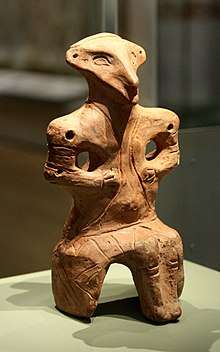
The Proto-Slavic root word *sъrbъ has been variously connected with Russian paserb (пасерб, "stepson"), Ukrainian pryserbytysia (присербитися, "join in"), Old Indic sarbh- ("fight, cut, kill"), Latin sero ("make up, constitute"), and Greek siro (ειρω, "repeat").[23] Polish linguist Stanisław Rospond (1906–1982) derived the Serbian language ethnonym Srb from srbati (cf. sorbo, absorbo).[24] Sorbian scholar H. Schuster-Šewc suggested a connection with the Proto-Slavic verb for "to slurp" *sьrb-, with cognates such as сёрбать (Russian), сьорбати (Ukrainian), сёрбаць (Belarusian), srbati (Slovak), сърбам (Bulgarian) and серебати (Old Russian).[25]
In his book, De Administrando Imperio, Constantine VII Porphyrogenitus suggests that the Serbs originated from White Serbia on the far side of Turkey. He believed that the people split in two, with the half that became known as the Serbs coming down to settle Byzantine land. In this line of thinking, Serb is derived from the word Surbi which was used to describe people of the proto-country.
From 1945 to 1963, the official name for Serbia was the People's Republic of Serbia, later renamed the Socialist Republic of Serbia from 1963 to 1990. Since 1990, the official name of the country has been the Republic of Serbia. From 1992 to 2006, however, the official names of the country Serbia was a part of were the Federal Republic of Yugoslavia and then the State Union of Serbia and Montenegro.[12]
.jpg)
History
Prehistory and antiquity
Archaeological evidence of Paleolithic settlements on the territory of present-day Serbia is scarce. A fragment of a human jaw was found in Sićevo (Mala Balanica) and is believed to be up to 525,000–397,000 years old.[28]
Approximately around 6,500 years BC, during the Neolithic, the Starčevo, and Vinča cultures existed in the region of modern-day Belgrade. They dominated much of Southeastern Europe, (as well as parts of Central Europe and Asia Minor). Several important archaeological sites from this era, including Lepenski Vir and Vinča-Belo Brdo, still exist near the banks of the Danube.[29][30]
During the Iron Age, local tribes of Triballi, Dardani, and Autariatae were encountered by the Ancient Greeks during their cultural and political expansion into the region, from the 5th up to the 2nd century BC. The Celtic tribe of Scordisci settled throughout the area in the 3rd century BC. It formed a tribal state, building several fortifications, including their capital at Singidunum (present-day Belgrade) and Naissos (present-day Niš).
The Romans conquered much of the territory in the 2nd century BC. In 167 BC the Roman province of Illyricum was established; the remainder was conquered around 75 BC, forming the Roman province of Moesia Superior; the modern-day Srem region was conquered in 9 BC; and Bačka and Banat in 106 AD after the Dacian Wars. As a result of this, contemporary Serbia extends fully or partially over several former Roman provinces, including Moesia, Pannonia, Praevalitana, Dalmatia, Dacia, and Macedonia.
The chief towns of Upper Moesia (and broader) were: Singidunum (Belgrade), Viminacium (now Old Kostolac), Remesiana (now Bela Palanka), Naissos (Niš), and Sirmium (now Sremska Mitrovica), the latter of which served as a Roman capital during the Tetrarchy.[31] Seventeen Roman Emperors were born in the area of modern-day Serbia, second only to contemporary Italy.[32] The most famous of these was Constantine the Great, the first Christian Emperor, who issued an edict ordering religious tolerance throughout the Empire.
When the Roman Empire was divided in 395, most of Serbia remained under the Eastern Roman Empire. At the same time, its northwestern parts were included in the Western Roman Empire. By the 6th century, South Slavs migrated into the European provinces of the Byzantine Empire in large numbers.[33] They merged with the local Romanised population that was gradually assimilated.[34][35][36]
Arrival of the Slavs and state formation
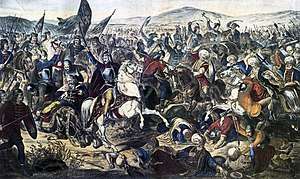
White Serbs, an early Slavic tribe from White Serbia first settled in an area near Thessaloniki on the Balkans and in the 6th and early 7th century, established the Serbian Principality by the 8th century.[38][39] It was said in 822 that the Serbs inhabited the more significant part of Roman Dalmatia,[40] their territory spanning what is today southwestern Serbia and parts of neighbouring countries. Meanwhile, the Byzantine Empire and the Bulgarian Empire held other parts of the territory. The Serbian rulers adopted Christianity in ca. 870, and by the mid-10th-century the Serbian state stretched to the Adriatic Sea by the Neretva, the Sava, the Morava, and Skadar. Between 1166 and 1371 Serbia was ruled by the Nemanjić dynasty (whose legacy is especially cherished), under whom the state was elevated to a kingdom (and briefly an empire) and Serbian bishopric to an autocephalous archbishopric (through the effort of Sava, the country's patron saint). Monuments of the Nemanjić period survive in many monasteries (several being World Heritage sites) and fortifications. During these centuries the Serbian state (and influence) expanded significantly. The northern part, Vojvodina, was ruled by the Kingdom of Hungary. The period known as the Fall of the Serbian Empire saw the once-powerful state fragmented into duchies, culminating in the Battle of Kosovo (1389) against the rising Ottoman Empire. The Ottomans finally conquered the Serbian Despotate in 1459. The Ottoman threat and eventual conquest saw massive migrations of Serbs to the west and north.[41]
Ottoman and Habsburg rule
In all Serbian lands conquered by the Ottomans, the native nobility was eliminated and the peasantry was enserfed to Ottoman rulers, while much of the clergy fled or were confined to the isolated monasteries. Under the Ottoman system, Serbs, as Christians, were considered an inferior class of people and subjected to heavy taxes, and a portion of the Serbian population experienced Islamization. Many Serbs were recruited during the devshirme system, a form of slavery in the Ottoman Empire, in which boys from Balkan Christian families were forcibly converted to Islam and trained for infantry units of the Ottoman army known as the Janissaries.[42][43][44][45] The Serbian Patriarchate of Peć was extinguished in 1463,[46] but reestablished in 1557,[47][48][49] providing for limited continuation of Serbian cultural traditions within the Ottoman Empire, under the Millet system.[50][51]
After the loss of statehood to the Ottoman Empire, Serbian resistance continued in northern regions (modern Vojvodina), under titular despots (until 1537), and popular leaders like Jovan Nenad (1526–1527). From 1521 to 1552, Ottomans conquered Belgrade and regions of Syrmia, Bačka, and Banat.[52] Continuing wars and various rebellions constantly challenged Ottoman rule. One of the most significant was the Banat Uprising in 1594 and 1595, which was part of the Long War (1593–1606) between the Habsburgs and the Ottomans.[53][54] The area of modern Vojvodina endured a century-long Ottoman occupation before being ceded to the Habsburg Empire, partially by the Treaty of Karlovci (1699),[55] and fully by the Treaty of Požarevac (1718).[56]
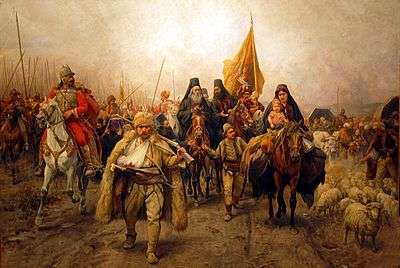
As the Great Serb Migrations depopulated most of southern Serbia, the Serbs sought refuge across the Danube River in Vojvodina to the north and the Military Frontier in the west, where they were granted rights by the Austrian crown under measures such as the Statuta Wallachorum of 1630. Much of central Serbia switched from Ottoman rule to Habsburg control (1686–91) during the Habsburg-Ottoman war (1683-1699). Following several petitions, Emperor Leopold I formally granted Serbs who wished to settle in the northern regions the right to their autonomous crown land.[57] The ecclesiastical centre of the Serbs also moved northwards, to the Metropolitanate of Karlovci,[58] and the Serbian Patriarchate of Peć was once-again abolished by the Ottomans in 1766.[59][60]
In 1718–39, the Habsburg Monarchy occupied much of Central Serbia and established the "Kingdom of Serbia" (1718–1739).[56] Those gains were lost by the Treaty of Belgrade in 1739, when the Ottomans retook the region.[61] Apart from territory of modern Vojvodina which remained under the Habsburg Empire, central regions of Serbia were occupied once again by the Habsburgs in 1788–1792.
Revolution and independence
The Serbian Revolution for independence from the Ottoman Empire lasted eleven years, from 1804 until 1815.[62][63][64][65] The revolution comprised two separate uprisings which gained autonomy from the Ottoman Empire (1830) that eventually evolved towards full independence (1878). During the First Serbian Uprising (1804–1813), led by vožd Karađorđe Petrović, Serbia was independent for almost a decade before the Ottoman army was able to reoccupy the country.[66] Shortly after this, the Second Serbian Uprising began in 1815. Led by Miloš Obrenović, it ended with a compromise between Serbian revolutionaries and Ottoman authorities.[67] Likewise, Serbia was one of the first nations in the Balkans to abolish feudalism.[68] The Akkerman Convention in 1826, the Treaty of Adrianople in 1829 and finally, the Hatt-i Sharif, recognised the suzerainty of Serbia. The First Serbian Constitution was adopted on 15 February 1835 (the anniversary of the outbreak of the First Serbian Uprising), making the country one of the first to adopt a democratic constitution in Europe.[69][70] 15 February is now commemorated as Statehood Day, a public holiday.[71]
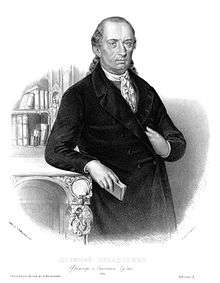
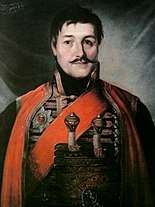
Right: Karađorđe Petrović, leader of the First Serbian Uprising
Following the clashes between the Ottoman army and Serbs in Belgrade in 1862,[72] and under pressure from the Great Powers, by 1867 the last Turkish soldiers left the Principality, making the country de facto independent.[73] By enacting a new constitution in 1869,[74] without consulting the Porte, Serbian diplomats confirmed the de facto independence of the country. In 1876, Serbia declared war on the Ottoman Empire, siding with the ongoing Christian uprisings in Bosnia-Herzegovina and Bulgaria.[75][76]
The formal independence of the country was internationally recognised at the Congress of Berlin in 1878, which ended the Russo-Turkish War; this treaty, however, prohibited Serbia from uniting with other Serbian regions by placing Bosnia and Herzegovina under Austro-Hungarian occupation, alongside the occupation of the region of Raška.[77] From 1815 to 1903, the Principality of Serbia was ruled by the House of Obrenović, save for the rule of Prince Aleksandar Karađorđević between 1842 and 1858. In 1882, Principality of Serbia became the Kingdom of Serbia, ruled by King Milan I.[78] The House of Karađorđević, descendants of the revolutionary leader Karađorđe Petrović, assumed power in 1903 following the May Overthrow.[79] In the north, the 1848 revolution in Austria led to the establishment of the autonomous territory of Serbian Vojvodina; by 1849, the region was transformed into the Voivodeship of Serbia and Banat of Temeschwar.[80]
The Balkan Wars and World War I
In the course of the First Balkan War in 1912, the Balkan League defeated the Ottoman Empire and captured its European territories, which enabled territorial expansion of the Kingdom of Serbia into regions of Raška, Kosovo, Metohija, and Vardarian Macedonia. The Second Balkan War soon ensued when Bulgaria turned on its former allies, but was defeated, resulting in the Treaty of Bucharest. In two years, Serbia enlarged its territory and its population by 50%; it also suffered high casualties on the eve of World War I, with more than 36,000 dead.[81] Austria-Hungary became wary of the rising regional power on its borders and its potential to become an anchor for unification of Serbs and other South Slavs, and the relationship between the two countries became tense.
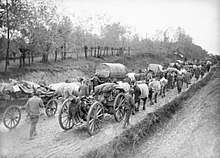
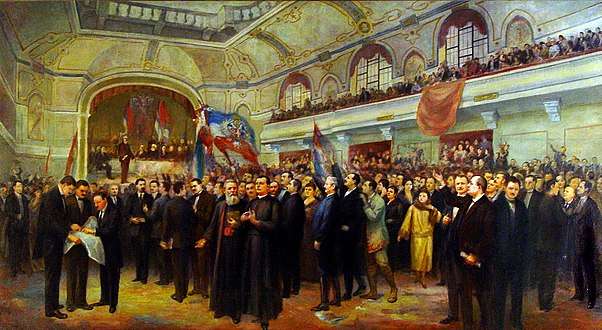
The assassination of Archduke Franz Ferdinand of Austria on 28 June 1914 in Sarajevo by Gavrilo Princip, a member of the Young Bosnia organisation, led to Austria-Hungary declaring war on Serbia, on 28 July.[83] Local war escalated, when Germany declared war on Russia, and invaded France and Belgium, thus drawing Great Britain into the conflict, that became the First World War. Serbia won the first major battles of World War I, including the Battle of Cer,[84] and the Battle of Kolubara, marking the first Allied victories against the Central Powers in World War I.[85]
Despite initial success, it was eventually overpowered by the Central Powers in 1915. Most of its army and some people retreated through Albania to Greece and Corfu, suffering immense losses on the way. Serbia was occupied by the Central Powers. After the Central Powers military situation on other fronts worsened, the remains of the Serb army returned east and lead a final breakthrough through enemy lines on 15 September 1918, liberating Serbia and defeating Bulgaria and Austria-Hungary.[86] Serbia, with its campaign, was a major Balkan Entente Power[87] which contributed significantly to the Allied victory in the Balkans in November 1918, especially by helping France force Bulgaria's capitulation.[88]
Serbia's casualties accounted for 8% of the total Entente military deaths; 58% (243,600) soldiers of the Serbian army perished in the war.[89] The total number of casualties is placed around 700,000,[90] more than 16% of Serbia's prewar size,[91] and a majority (57%) of its overall male population.[92][93][94] Serbia suffered the biggest casualty rate in World War I.[95]
As the Austro-Hungarian Empire collapsed, the territory of Syrmia united with Serbia on 24 November 1918. Just a day later on November 25, 1918 Grand National Assembly of Serbs, Bunjevci and other Slavs in Banat, Bačka and Baranja declared the unification of Banat, Bačka, and Baranja to the Kingdom of Serbia.[96]
Kingdom of Yugoslavia, World War II, and the second Yugoslavia
On 26 November 1918, the Podgorica Assembly deposed the House of Petrović-Njegoš and united Montenegro with Serbia.[97] On 1 December 1918, in Belgrade, Serbian Prince Regent Alexander Karađorđević proclaimed the Kingdom of the Serbs, Croats, and Slovenes, under King Peter I of Serbia.[98][99]
King Peter was succeeded by his son, Alexander, in August 1921. Serb centralists and Croat autonomists clashed in the parliament, and most governments were fragile and short-lived. Nikola Pašić, a conservative prime minister, headed or dominated most governments until his death. King Alexander established a dictatorship in 1929 with the aim of establishing the Yugoslav ideology and single Yugoslav nation, changed the name of the country to Yugoslavia and changed the internal divisions from the 33 oblasts to nine new banovinas. The effect of Alexander's dictatorship was to further alienate the non-Serbs living in Yugoslavia from the idea of unity.[100]
Alexander was assassinated in Marseille, during an official visit in 1934 by Vlado Chernozemski, member of the IMRO. Alexander was succeeded by his eleven-year-old son Peter II and a regency council was headed by his cousin, Prince Paul. In August 1939 the Cvetković–Maček Agreement established an autonomous Banate of Croatia as a solution to Croatian concerns.
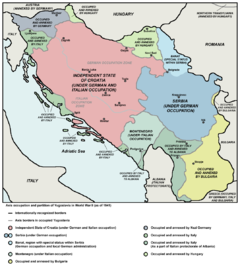
In 1941, in spite of Yugoslav attempts to remain neutral in the war, the Axis powers invaded Yugoslavia. The territory of modern Serbia was divided between Hungary, Bulgaria, the Independent State of Croatia and Italy (Greater Albania and Montenegro), while the remaining part of the occupied Serbia was placed under the military administration of the Nazi Germany, with Serbian puppet governments led by Milan Aćimović and Milan Nedić assisted by Dimitrije Ljotić's fascist organization Yugoslav National Movement (Zbor).
The Yugoslav territory was the scene of a civil war between royalist Chetniks commanded by Draža Mihailović and communist partisans commanded by Josip Broz Tito. Axis auxiliary units of the Serbian Volunteer Corps and the Serbian State Guard fought against both of these forces. Siege of Kraljevo was a major battle of the Uprising in Serbia, led by Chetnik forces against the Nazis. Several days after the battle began the German forces committed a massacre of approximately 2,000 civilians in an event known as the Kraljevo massacre, in a reprisal for the attack. Draginac and Loznica massacre of 2,950 villagers in Western Serbia in 1941 was the first large execution of civilians in occupied Serbia by Germans, with Kragujevac massacre and Novi Sad Raid of Jews and Serbs by Hungarian fascists being the most notorious, with over 3,000 victims in each case.[101][102][103] After one year of occupation, around 16,000 Serbian Jews were murdered in the area, or around 90% of its pre-war Jewish population during The Holocaust in Serbia. Many concentration camps were established across the area. Banjica concentration camp was the largest concentration camp and jointly run by the German army and Nedić's regime [104], with primary victims being Serbian Jews, Roma, and Serb political prisoners.[105]
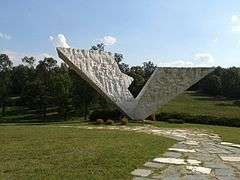
During this period, hundreds of thousands of ethnic Serbs fled the Axis puppet state known as the Independent State of Croatia and sought refuge in German-occupied Serbia, seeking to escape the large-scale persecution and genocide of Serbs, Jews, and Roma being committed by the Ustaše regime.[106]
According to Josip Broz Tito himself, Serbs made up the vast majority of Anti-fascist fighters and Yugoslav Partisans for the whole course of World War II.[107] The Republic of Užice was a short-lived liberated territory established by the Partisans and the first liberated territory in World War II Europe, organised as a military mini-state that existed in the autumn of 1941 in the west of occupied Serbia. By late 1944, the Belgrade Offensive swung in favour of the partisans in the civil war; the partisans subsequently gained control of Yugoslavia.[108] Following the Belgrade Offensive, the Syrmian Front was the last major military action of World War II in Serbia. A study by Vladimir Žerjavić estimates total war related deaths in Yugoslavia at 1,027,000, including 273,000 in Serbia.[109] The Ustaše regime committed the Genocide of Serbs and systematically murdered approximately 300,000 to 500,000 Serbs.[110][111][112]
The victory of the Communist Partisans resulted in the abolition of the monarchy and a subsequent constitutional referendum. A one-party state was soon established in Yugoslavia by the Communist Party of Yugoslavia. It is claimed between 60,000 and 70,000 people died in Serbia during the 1944–45 communist takeover and purge.[113] All opposition was suppressed and people deemed to be promoting opposition to socialism or promoting separatism were imprisoned or executed for sedition. Serbia became a constituent republic within the SFRY known as the Socialist Republic of Serbia, and had a republic-branch of the federal communist party, the League of Communists of Serbia.
Serbia's most powerful and influential politician in Tito-era Yugoslavia was Aleksandar Ranković, one of the "big four" Yugoslav leaders, alongside Tito, Edvard Kardelj, and Milovan Đilas.[114] Ranković was later removed from the office because of the disagreements regarding Kosovo's nomenklatura and the unity of Serbia.[114] Ranković's dismissal was highly unpopular among Serbs.[115] Pro-decentralisation reformers in Yugoslavia succeeded in the late 1960s in attaining substantial decentralisation of powers, creating substantial autonomy in Kosovo and Vojvodina, and recognising a distinctive "Muslim" nationality.[115] As a result of these reforms, there was a massive overhaul of Kosovo's nomenklatura and police, that shifted from being Serb-dominated to ethnic Albanian-dominated through firing Serbs on a large scale.[115] Further concessions were made to the ethnic Albanians of Kosovo in response to unrest, including the creation of the University of Pristina as an Albanian language institution.[115] These changes created widespread fear among Serbs of being treated as second-class citizens.[116]
Belgrade, the capital of SFR Yugoslavia and SR Serbia, hosted the first Non-Aligned Movement Summit in September 1961, as well as the first major gathering of the Organization for Security and Co-operation in Europe (OSCE) with the aim of implementing the Helsinki Accords from October 1977 to March 1978.[117][118] The 1972 smallpox outbreak in SAP Kosovo and other parts of SR Serbia was the last major outbreak of smallpox in Europe since World War II.[119]
Breakup of Yugoslavia, political transition, and contemporary history
In 1989, Slobodan Milošević rose to power in Serbia. Milošević promised a reduction of powers for the autonomous provinces of Kosovo and Vojvodina, where his allies subsequently took over power, during the Anti-bureaucratic revolution.[120] This ignited tensions between the communist leadership of the other republics of Yugoslavia, and awoke ethnic nationalism across Yugoslavia that eventually resulted in its breakup, with Slovenia, Croatia, Bosnia and Herzegovina, and Macedonia declaring independence during 1991 and 1992.[121] Serbia and Montenegro remained together as the Federal Republic of Yugoslavia (FRY).[11] However, according to the Badinter Commission, the country was not legally considered a continuation of the former SFRY, but a new state.
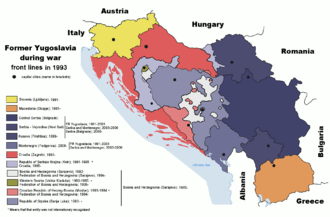
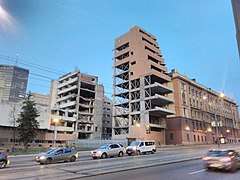
Fueled by ethnic tensions, the Yugoslav Wars (1991–2001) erupted, with the most severe conflicts taking place in Croatia and Bosnia, where the large ethnic Serb communities opposed independence from Yugoslavia. The FRY remained outside the conflicts, but provided logistic, military and financial support to Serb forces in the wars. In response, the UN imposed sanctions against Serbia which led to political isolation and the collapse of the economy (GDP decreased from $24 billion in 1990 to under $10 billion in 1993). Following the rise of nationalism and political tensions after Slobodan Milošević came to power, numerous anti-war movements developed in Serbia and many anti-war protests were held in Belgrade.[122][123]
Multi-party democracy was introduced in Serbia in 1990, officially dismantling the one-party system. Critics of Milošević stated that the government continued to be authoritarian despite constitutional changes, as Milošević maintained strong political influence over the state media and security apparatus.[124][125] When the ruling Socialist Party of Serbia refused to accept its defeat in municipal elections in 1996, Serbians engaged in large protests against the government.
In 1998, continued clashes between the Albanian guerilla Kosovo Liberation Army and Yugoslav security forces led to the short Kosovo War (1998–99), in which NATO intervened, leading to the withdrawal of Serbian forces and the establishment of UN administration in the province.[126] After the Yugoslav Wars, Serbia became home to highest number of refugees and internally displaced persons in Europe.[127][128][129]
After presidential elections in September 2000, opposition parties accused Milošević of electoral fraud. A campaign of civil resistance followed, led by the Democratic Opposition of Serbia (DOS), a broad coalition of anti-Milošević parties. This culminated on 5 October when half a million people from all over the country congregated in Belgrade, compelling Milošević to concede defeat.[130] The fall of Milošević ended Yugoslavia's international isolation. Milošević was sent to the International Criminal Tribunal for the former Yugoslavia. The DOS announced that FR Yugoslavia would seek to join the European Union. In 2003, the Federal Republic of Yugoslavia was renamed Serbia and Montenegro;[131] the EU opened negotiations with the country for the Stabilisation and Association Agreement. Serbia's political climate remained tense and in 2003, the Prime Minister Zoran Đinđić was assassinated as result of a plot originating from circles of organised crime and former security officials.
On 21 May 2006, Montenegro held a referendum to determine whether to end its union with Serbia. The results showed 55.4% of voters in favour of independence, which was just above the 55% required by the referendum. On 5 June 2006, the National Assembly of Serbia declared Serbia to be the legal successor to the former state union.[132] The Assembly of Kosovo unilaterally declared independence from Serbia on 17 February 2008. Serbia immediately condemned the declaration and continues to deny any statehood to Kosovo. The declaration has sparked varied responses from the international community, some welcoming it, while others condemned the unilateral move.[133] Status-neutral talks between Serbia and Kosovo-Albanian authorities are held in Brussels, mediated by the EU.
In April 2008 Serbia was invited to join the Intensified Dialogue programme with NATO, despite the diplomatic rift with the alliance over Kosovo.[134] Serbia officially applied for membership in the European Union on 22 December 2009,[135] and received candidate status on 1 March 2012, following a delay in December 2011.[136][137] Following a positive recommendation of the European Commission and European Council in June 2013, negotiations to join the EU commenced in January 2014.[138]
Since Aleksandar Vučić came to power, Serbia has suffered from democratic backsliding into authoritarianism[139][140][141], followed by a decline in media freedom and civil liberties.[142][143] Massive anti-government protests began in 2018 and continued into 2020, making them one of Europe's longest-running protests.[144] After the COVID-19 pandemic spread to Serbia in March 2020, a state of emergency was declared and a curfew was introduced for the first time in Serbia since World War II.[145]
Geography
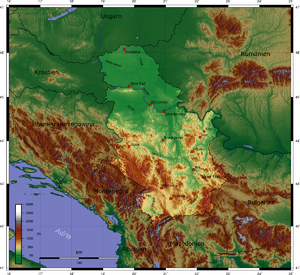
Situated at the crossroads between Central[18][146][147] and Southern Europe, Serbia is located in the Balkan peninsula and the Pannonian Plain. Serbia lies between latitudes 41° and 47° N, and longitudes 18° and 23° E. The country covers a total of 88,361 km2 (including Kosovo), which places it at 113th place in the world; with Kosovo excluded, the total area is 77,474 km2,[1] which would make it 117th. Its total border length amounts to 2,027 km (Albania 115 km, Bosnia and Herzegovina 302 km, Bulgaria 318 km, Croatia 241 km, Hungary 151 km, North Macedonia 221 km, Montenegro 203 km and Romania 476 km).[1] All of Kosovo's border with Albania (115 km), North Macedonia (159 km) and Montenegro (79 km)[148] are under control of the Kosovo border police.[149] Serbia treats the 352 km long border between Kosovo and rest of Serbia as an "administrative line"; it is under shared control of Kosovo border police and Serbian police forces, and there are 11 crossing points.[150] The Pannonian Plain covers the northern third of the country (Vojvodina and Mačva[151]) while the easternmost tip of Serbia extends into the Wallachian Plain. The terrain of the central part of the country, with the region of Šumadija at its heart, consists chiefly of hills traversed by rivers. Mountains dominate the southern third of Serbia. Dinaric Alps stretch in the west and the southwest, following the flow of the rivers Drina and Ibar. The Carpathian Mountains and Balkan Mountains stretch in a north–south direction in eastern Serbia.[152]
Ancient mountains in the southeast corner of the country belong to the Rilo-Rhodope Mountain system. Elevation ranges from the Midžor peak of the Balkan Mountains at 2,169 metres (7,116 feet) (the highest peak in Serbia, excluding Kosovo) to the lowest point of just 17 metres (56 feet) near the Danube river at Prahovo.[153] The largest lake is Đerdap Lake (163 square kilometres) and the longest river passing through Serbia is the Danube (587.35 kilometres).
Climate
The climate of Serbia is under the influences of the landmass of Eurasia and the Atlantic Ocean and Mediterranean Sea. With mean January temperatures around 0 °C (32 °F), and mean July temperatures of 22 °C (72 °F), it can be classified as a warm-humid continental or humid subtropical climate.[154] In the north, the climate is more continental, with cold winters, and hot, humid summers along with well-distributed rainfall patterns. In the south, summers and autumns are drier, and winters are relatively cold, with heavy inland snowfall in the mountains.
Differences in elevation, proximity to the Adriatic Sea and large river basins, as well as exposure to the winds account for climate variations.[155] Southern Serbia is subject to Mediterranean influences.[156] The Dinaric Alps and other mountain ranges contribute to the cooling of most of the warm air masses. Winters are quite harsh in the Pešter plateau, because of the mountains which encircle it.[157] One of the climatic features of Serbia is Košava, a cold and very squally southeastern wind which starts in the Carpathian Mountains and follows the Danube northwest through the Iron Gate where it gains a jet effect and continues to Belgrade and can spread as far south as Niš.[158]
The average annual air temperature for the period 1961–1990 for the area with an altitude of up to 300 m (984 ft) is 10.9 °C (51.6 °F). The areas with an altitude of 300 to 500 m (984 to 1,640 ft) have an average annual temperature of around 10.0 °C (50.0 °F), and over 1,000 m (3,281 ft) of altitude around 6.0 °C (42.8 °F).[159] The lowest recorded temperature in Serbia was −39.5 °C (−39.1 °F) on 13 January 1985, Karajukića Bunari in Pešter, and the highest was 44.9 °C (112.8 °F), on 24 July 2007, recorded in Smederevska Palanka.[160]
Serbia is one of few European countries with very high risk exposure to natural hazards (earthquakes, storms, floods, droughts).[161] It is estimated that potential floods, particularly in areas of Central Serbia, threaten over 500 larger settlements and an area of 16,000 square kilometres.[162] The most disastrous were the floods in May 2014, when 57 people died and a damage of over a 1.5 billion euro was inflicted.[163]
Hydrology
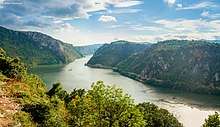
Almost all of Serbia's rivers drain to the Black Sea, by way of the Danube river. The Danube, the second largest European river, passes through Serbia with 588 kilometres[164] (21% of its overall length) and represents the major source of fresh water.[165][166] It is joined by its biggest tributaries, the Great Morava (longest river entirely in Serbia with 493 km of length[167]), Sava and Tisza rivers.[168] One notable exception is the Pčinja which flows into the Aegean. Drina river forms the natural border between Bosnia and Herzegovina and Serbia, and represents the main kayaking and rafting attraction in both countries.
Due to configuration of the terrain, natural lakes are sparse and small; most of them are located in the lowlands of Vojvodina, like the aeolian lake Palić or numerous oxbow lakes along river flows (like Zasavica and Carska Bara). However, there are numerous artificial lakes, mostly due to hydroelectric dams, the biggest being Đerdap (Iron Gates) on the Danube with 163 km2 on the Serbian side[169] (a total area of 253 km2 is shared with Romania); Perućac on the Drina, and Vlasina. The largest waterfall, Jelovarnik, located in Kopaonik, is 71 m high.[170] Abundance of relatively unpolluted surface waters and numerous underground natural and mineral water sources of high water quality presents a chance for export and economy improvement; however, more extensive exploitation and production of bottled water began only recently.
Environment
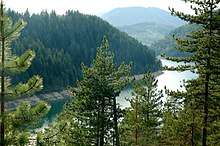

With 29.1% of its territory covered by forest, Serbia is considered to be a middle-forested country, compared on a global scale to world forest coverage at 30%, and European average of 35%. The total forest area in Serbia is 2,252,000 ha (1,194,000 ha or 53% are state-owned, and 1,058,387 ha or 47% are privately owned) or 0.3 ha per inhabitant.[171]
The most common trees are oak, beech, pines, and firs. Serbia is a country of rich ecosystem and species diversity—covering only 1.9% of the whole European territory, Serbia is home to 39% of European vascular flora, 51% of European fish fauna, 40% of European reptiles and amphibian fauna, 74% of European bird fauna, and 67% European mammal fauna.[172] Its abundance of mountains and rivers make it an ideal environment for a variety of animals, many of which are protected including wolves, lynx, bears, foxes, and stags. There are 17 snake species living all over the country, 8 of them are venomous.[173]
Mountain of Tara in western Serbia is one of the last regions in Europe where bears can still live in absolute freedom.[174] Serbia is home home to about 380 species of birds. In Carska Bara, there are over 300 bird species on just a few square kilometres.[175] Uvac Gorge is considered one of the last habitats of the Griffon vulture in Europe.[176] In area around the city of Kikinda, in the northernmost part of the country, some 145 endangered long-eared owls are noted, making it the world's biggest settlement of these species.[177] The country is considerably rich with threatened species of bats and butterflies as well.[178]
There are 380 protected areas of Serbia, encompassing 4,947 square kilometres or 6.4% of the country. The "Spatial plan of the Republic of Serbia" states that the total protected area should be increased to 12% by 2021.[172] Those protected areas include 5 national parks (Đerdap, Tara, Kopaonik, Fruška Gora and Šar Mountain), 15 nature parks, 15 "landscapes of outstanding features", 61 nature reserves, and 281 natural monuments.[170]
Air pollution is a significant problem in Bor area, due to work of large copper mining and smelting complex, and Pančevo where oil and petrochemical industry is based.[179] Some cities suffer from water supply problems, due to mismanagement and low investments in the past, as well as water pollution (like the pollution of the Ibar River from the Trepča zinc-lead combinate,[180] affecting the city of Kraljevo, or the presence of natural arsenic in underground waters in Zrenjanin).[181]
Poor waste management has been identified as one of the most important environmental problems in Serbia and the recycling is a fledgling activity, with only 15% of its waste being turned back for reuse.[182] The 1999 NATO bombing caused serious damage to the environment, with several thousand tonnes of toxic chemicals stored in targeted factories and refineries released into the soil and water basins.[183]
Politics
Serbia is a parliamentary republic, with the government divided into legislative, executive, and judiciary branches. Serbia had one of the first modern constitutions in Europe, the 1835 Constitution (known as the Sretenje Constitution), which was at the time considered among the most progressive and liberal constitutions in Europe.[184][185] Since then it has adopted 10 different constitutions.[186] The current constitution was adopted in 2006 in the aftermath of Montenegro independence referendum which by consequence renewed the independence of Serbia itself.[187] The Constitutional Court rules on matters regarding the Constitution.
The President of the Republic (Predsednik Republike) is the head of state, is elected by popular vote to a five-year term and is limited by the Constitution to a maximum of two terms. In addition to being the commander in chief of the armed forces, the president has the procedural duty of appointing the prime minister with the consent of the parliament, and has some influence on foreign policy.[188] Aleksandar Vučić of the Serbian Progressive Party is the current president following the 2017 presidential election.[189] Seat of the presidency is Novi Dvor.
The Government (Vlada) is composed of the prime minister and cabinet ministers. The Government is responsible for proposing legislation and a budget, executing the laws, and guiding the foreign and internal policies. The current prime minister is Ana Brnabić, nominated by the Serbian Progressive Party.[190]
The National Assembly (Narodna skupština) is a unicameral legislative body. The National Assembly has the power to enact laws, approve the budget, schedule presidential elections, select and dismiss the Prime Minister and other ministers, declare war, and ratify international treaties and agreements.[191] It is composed of 250 proportionally elected members who serve four-year terms.
The largest political parties in Serbia are the centre-right Serbian Progressive Party, leftist Socialist Party of Serbia and far-right Serbian Radical Party.[192]
Law and criminal justice
Serbia is the fourth modern-day European country, after France, Austria and the Netherlands, to have a codified legal system.[193]
The country has a three-tiered judicial system, made up of the Supreme Court of Cassation as the court of the last resort, Courts of Appeal as the appellate instance, and Basic and High courts as the general jurisdictions at first instance.[194][195]
Courts of special jurisdictions are the Administrative Court, commercial courts (including the Commercial Court of Appeal at second instance) and misdemeanor courts (including High Misdemeanor Court at second instance).[196] The judiciary is overseen by the Ministry of Justice. Serbia has a typical civil law legal system.
Law enforcement is the responsibility of the Serbian Police, which is subordinate to the Ministry of the Interior. Serbian Police fields 27,363 uniformed officers.[197] National security and counterintelligence are the responsibility of the Security Intelligence Agency (BIA).[198]

Foreign relations
Serbia has established diplomatic relations with 188 UN member states, the Holy See, the Sovereign Military Order of Malta, and the European Union.[199] Foreign relations are conducted through the Ministry of Foreign Affairs. Serbia has a network of 65 embassies and 23 consulates internationally.[200] There are 69 foreign embassies, 5 consulates and 4 liaison offices in Serbia.[201][202]
Serbian foreign policy is focused on achieving the strategic goal of becoming a member state of the European Union (EU). Serbia started the process of joining the EU by signing of the Stabilisation and Association Agreement on 29 April 2008 and officially applied for membership in the European Union on 22 December 2009.[203] It received a full candidate status on 1 March 2012 and started accession talks on 21 January 2014.[204][205] The European Commission considers accession possible by 2025.[206]
The province of Kosovo declared independence from Serbia on 17 February 2008, which sparked varied responses from the international community, some welcoming it, while others condemn the unilateral move.[133] In protest, Serbia initially recalled its ambassadors from countries that recognised Kosovo's independence.[207] The resolution of 26 December 2007 by the National Assembly stated that both the Kosovo declaration of independence and recognition thereof by any state would be gross violation of international law.[208]
Serbia began cooperation and dialogue with NATO in 2006, when the country joined the Partnership for Peace programme and the Euro-Atlantic Partnership Council. The country's military neutrality was formally proclaimed by a resolution adopted by Serbia's parliament in December 2007, which makes joining any military alliance contingent on a popular referendum,[209][210] a stance acknowledged by NATO.[211][212][213] On the other hand, Serbia's relations with Russia are habitually described by mass media as a "centuries-old religious, ethnic and political alliance"[214] and Russia is said to have sought to solidify its relationship with Serbia since the imposition of sanctions against Russia in 2014.[215]
Military
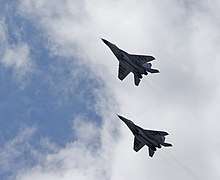
The Serbian Armed Forces are subordinate to the Ministry of Defence, and are composed of the Army and the Air Force. Although a landlocked country, Serbia operates a River Flotilla which patrols on the Danube, Sava, and Tisza rivers. The Serbian Chief of the General Staff reports to the Defence Minister. The Chief of Staff is appointed by the President, who is the Commander-in-chief.[188] As of 2019, Serbian defence budget amounts to $804 million.[216]
Traditionally having relied on a large number of conscripts, Serbian Armed Forces went through a period of downsizing, restructuring and professionalisation. Conscription was abolished in 2011.[217] Serbian Armed Forces have 28,000 active troops,[218] supplemented by the "active reserve" which numbers 20,000 members and "passive reserve" with about 170,000.[219][220]
Serbia participates in the NATO Individual Partnership Action Plan programme,[211] but has no intention of joining NATO, due to significant popular rejection, largely a legacy of the NATO bombing of Yugoslavia in 1999.[221] It is an observer member of the Collective Securities Treaty Organisation (CSTO)[222] The country also signed the Stability Pact for South Eastern Europe. The Serbian Armed Forces take part in several multinational peacekeeping missions, including deployments in Lebanon, Cyprus, Ivory Coast, and Liberia.[223]
Serbia is a major producer and exporter of military equipment in the region. Defence exports totaled around $600 million in 2018.[224] The defence industry has seen significant growth over the years and it continues to grow on a yearly basis.[225][226]
Administrative divisions
Serbia is a unitary state[227] composed of municipalities/cities, districts, and two autonomous provinces. In Serbia, excluding Kosovo, there are 145 municipalities (opštine) and 29 cities (gradovi), which form the basic units of local self-government.[228] Apart from municipalities/cities, there are 24 districts (okruzi, 10 most populated listed below), with the City of Belgrade constituting an additional district. Except for Belgrade, which has an elected local government, districts are regional centres of state authority, but have no powers of their own; they present purely administrative divisions.[228]
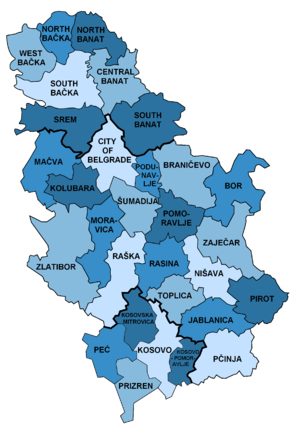
The Constitution of Serbia recognizes two autonomous provinces, Vojvodina in the north, and the disputed territory of Kosovo and Metohija in the south,[228] while the remaining area of Central Serbia never had its own regional authority. Following the Kosovo War, UN peacekeepers entered Kosovo and Metohija, as per UNSC Resolution 1244. In 2008, Kosovo declared independence.[229] The government of Serbia did not recognise the declaration, considering it illegal and illegitimate.[230]
Demographics
As of 2011 census, Serbia (excluding Kosovo) has a total population of 7,186,862 and the overall population density is medium as it stands at 92.8 inhabitants per square kilometre.[231] The census was not conducted in Kosovo which held its own census that numbered their total population at 1,739,825,[232] excluding Serb-inhabited North Kosovo, as Serbs from that area (about 50,000) boycotted the census.
Serbia has been enduring a demographic crisis since the beginning of the 1990s, with a death rate that has continuously exceeded its birth rate.[233][234] It is estimated that 300,000 people left Serbia during the 1990s, 20% of whom had a higher education.[235][236] Serbia subsequently has one of the oldest populations in the world, with the average age of 42.9 years,[2] and its population is shrinking at one of the fastest rates in the world.[237] A fifth of all households consist of only one person, and just one-fourth of four and more persons.[238] Average life expectancy in Serbia at birth is 76.1 years.[239]
During the 1990s, Serbia had the largest refugee population in Europe.[240] Refugees and internally displaced persons (IDPs) in Serbia formed between 7% and 7.5% of its population at the time – about half a million refugees sought refuge in the country following the series of Yugoslav wars, mainly from Croatia (and to a lesser extent from Bosnia and Herzegovina) and the IDPs from Kosovo.[241]
Serbs with 5,988,150 are the largest ethnic group in Serbia, representing 83% of the total population (excluding Kosovo). Serbia is one of the European countries with high numbers of registered national minorities, while the Autonomous Province of Vojvodina is recognizable for its multi-ethnic and multi-cultural identity.[242][243][244] With a population of 253,899, Hungarians are the largest ethnic minority in Serbia, concentrated predominantly in northern Vojvodina and representing 3.5% of the country's population (13% in Vojvodina). Romani population stands at 147,604 according to the 2011 census but unofficial estimates place their actual number between 400,000 and 500,000.[245] Bosniaks with 145,278 are concentrated in Raška (Sandžak), in the southwest. Other minority groups include Croats, Slovaks, Albanians, Montenegrins, Vlachs, Romanians, Macedonians and Bulgarians. Chinese, estimated at about 15,000, are the only significant non-European immigrant minority.[246][247]
The majority of the population, or 59.4%, reside in urban areas and some 16.1% in Belgrade alone. Belgrade is the only city with more than a million inhabitants and there are four more with over 100,000 inhabitants.[248]
Religion
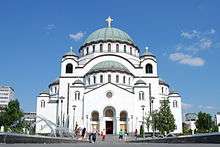
The Constitution of Serbia defines it as a secular state with guaranteed religious freedom. Orthodox Christians with 6,079,396 comprise 84.5% of country's population. The Serbian Orthodox Church is the largest and traditional church of the country, adherents of which are overwhelmingly Serbs. Other Orthodox Christian communities in Serbia include Montenegrins, Romanians, Vlachs, Macedonians and Bulgarians.
Roman Catholics number 356,957 in Serbia, or roughly 6% of the population, mostly in Vojvodina (especially its northern part) which is home to minority ethnic groups such as Hungarians, Croats, Bunjevci, as well as to some Slovaks and Czechs.[250]
Protestantism accounts for about 1% of the country's population, chiefly Lutheranism among Slovaks in Vojvodina as well as Calvinism among Reformed Hungarians. Greek Catholic Church is adhered by around 25,000 citizens (0.37% of the population), mostly Rusyns in Vojvodina.[251]
Muslims, with 222,282 or 3% of the population, form the third largest religious group. Islam has a strong historic following in the southern regions of Serbia, primarily in southern Raška. Bosniaks are the largest Islamic community in Serbia; estimates are that around a third of the country's Roma people are Muslim.
There are only 578 Jews in Serbia.[252] Atheists numbered 80,053 or 1.1% of the population and an additional 4,070 declared themselves to be agnostics.[252]
Language
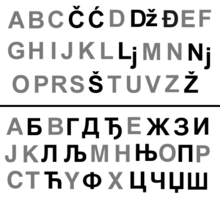
The official language is Serbian, native to 88% of the population.[252] Serbian is the only European language with active digraphia, using both Cyrillic and Latin alphabets. Serbian Cyrillic is designated in the Constitution as the "official script" and was devised in 1814 by Serbian philologist Vuk Karadžić, who based it on phonemic principles.[253] A survey from 2014 showed that 47% of Serbians favour the Latin alphabet, 36% favour the Cyrillic one and 17% have no preference.[254]
Standard Serbian is based on the most widespread Shtokavian dialect (more specifically on the dialects of Šumadija-Vojvodina and Eastern Herzegovina[255]).
Recognised minority languages are: Hungarian, Bosnian, Slovak, Croatian, Albanian, Romanian, Bulgarian, Rusyn, and Macedonian. All these languages are in official use in municipalities or cities where the ethnic minority exceeds 15% of the total population.[256] In Vojvodina, the provincial administration uses, besides Serbian, five other languages (Hungarian, Slovak, Croatian, Romanian and Rusyn).
Economy
Serbia has an emerging market economy in upper-middle income range.[257] According to the International Monetary Fund, Serbian nominal GDP in 2018 is officially estimated at $50.651 billion or $7,243 per capita while purchasing power parity GDP stood at $122.759 billion or $17,555 per capita.[258] The economy is dominated by services which accounts for 67.9% of GDP, followed by industry with 26.1% of GDP, and agriculture at 6% of GDP.[259] The official currency of Serbia is Serbian dinar (ISO code: RSD), and the central bank is National Bank of Serbia. The Belgrade Stock Exchange is the only stock exchange in the country, with market capitalisation of $8.65 billion and BELEX15 as the main index representing the 15 most liquid stocks.[260]
The economy has been affected by the global economic crisis. After almost a decade of strong economic growth (average of 4.45% per year), Serbia entered the recession in 2009 with negative growth of −3% and again in 2012 and 2014 with −1% and −1.8%, respectively.[261] As the government was fighting effects of crisis the public debt has more than doubled: from pre-crisis level of just under 30% to about 70% of GDP and trending downwards recently to around 50%.[262][263] Labour force stands at 3.2 million, with 56% employed in services sector, 28.1% in industry and 15.9% in the agriculture.[264] The average monthly net salary in May 2019 stood at 47,575 dinars or $525.[265] The unemployment remains an acute problem, with rate of 12.7% as of 2018.[264]
Since 2000, Serbia has attracted over $40 billion in foreign direct investment (FDI).[266] Blue-chip corporations making investments include: Fiat Chrysler Automobiles, Siemens, Bosch, Philip Morris, Michelin, Coca-Cola, Carlsberg and others.[267] In the energy sector, Russian energy giants, Gazprom and Lukoil have made large investments.[268] In metallurgy sector, Chinese steel and copper giants, Hesteel and Zijin Mining have acquired key complexes.[269]
Serbia has an unfavourable trade balance: imports exceed exports by 25%. Serbia's exports, however, recorded a steady growth in last couple of years reaching $19.2 billion in 2018.[270] The country has free trade agreements with the EFTA and CEFTA, a preferential trade regime with the European Union, a Generalised System of Preferences with the United States, and individual free trade agreements with Russia, Belarus, Kazakhstan, and Turkey.[271]
Agriculture
Serbia has very favourable natural conditions (land and climate) for varied agricultural production. It has 5,056,000 ha of agricultural land (0.7 ha per capita), out of which 3,294,000 ha is arable land (0.45 ha per capita).[274] In 2016, Serbia exported agricultural and food products worth $3.2 billion, and the export-import ratio was 178%.[275] Agricultural exports constitute more than one-fifth of all Serbia's sales on the world market. Serbia is one of the largest provider of frozen fruit to the EU (largest to the French market, and 2nd largest to the German market).[276]
Agricultural production is most prominent in Vojvodina on the fertile Pannonian Plain. Other agricultural regions include Mačva, Pomoravlje, Tamnava, Rasina, and Jablanica.[277]
In the structure of the agricultural production 70% is from the crop field production, and 30% is from the livestock production.[277] Serbia is world's second largest producer of plums (582,485 tonnes; second to China), second largest of raspberries (89,602 tonnes, second to Poland), it is also a significant producer of maize (6.48 million tonnes, ranked 32nd in the world) and wheat (2.07 million tonnes, ranked 35th in the world).[170][278] Other important agricultural products are: sunflower, sugar beet, soybean, potato, apple, pork meat, beef, poultry and dairy.
There are 56,000 ha of vineyards in Serbia, producing about 230 million litres of wine annually.[170][274] Most famous viticulture regions are located in Vojvodina and Šumadija.
Industry
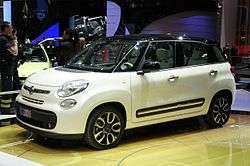
The industry was the economic sector hardest hit by the UN sanctions and trade embargo and NATO bombing during the 1990s and transition to market economy during the 2000s.[279] The industrial output saw dramatic downsizing: in 2013 it was expected to be only a half of that of 1989.[280] Main industrial sectors include: automotive, mining, non-ferrous metals, food-processing, electronics, pharmaceuticals, clothes. Serbia has 14 free economic zones as of September 2017,[281] in which many foreign direct investments are realised.
Automotive industry (with Fiat Chrysler Automobiles as a forebearer) is dominated by cluster located in Kragujevac and its vicinity, and contributes to export with about $2 billion.[282] Country is a leading steel producer in the wider region of Southeast Europe and had production of nearly 2 million tonnes of raw steel in 2018, coming entirely from Smederevo steel mill, owned by the Chinese Hesteel.[283] Serbia's mining industry is comparatively strong: Serbia is the 18th largest producer of coal (7th in the Europe) extracted from large deposits in Kolubara and Kostolac basins; it is also world's 23rd largest (3rd in Europe) producer of copper which is extracted by Zijin Bor Copper, a large copper mining company, acquired by Chinese Zijin Mining in 2018; significant gold extraction is developed around Majdanpek. Serbia notably manufactures intel smartphones named Tesla smartphones.[284]
Food industry is well known both regionally and internationally and is one of the strong points of the economy.[285] Some of the international brand-names established production in Serbia: PepsiCo and Nestlé in food-processing sector; Coca-Cola (Belgrade), Heineken (Novi Sad) and Carlsberg (Bačka Palanka) in beverage industry; Nordzucker in sugar industry.[276] Serbia's electronics industry had its peak in the 1980s and the industry today is only a third of what it was back then, but has witnessed a something of revival in last decade with investments of companies such as Siemens (wind turbines) in Subotica, Panasonic (lighting devices) in Svilajnac, and Gorenje (electrical home appliances) in Valjevo.[286] The pharmaceutical industry in Serbia comprises a dozen manufacturers of generic drugs, of which Hemofarm in Vršac and Galenika in Belgrade, account for 80% of production volume. Domestic production meets over 60% of the local demand.[287]
Energy

The energy sector is one of the largest and most important sectors to the country's economy. Serbia is a net exporter of electricity and importer of key fuels (such as oil and gas).
Serbia has an abundance of coal, and significant reserves of oil and gas. Serbia's proven reserves of 5.5 billion tonnes of coal lignite are the 5th largest in the world (second in Europe, after Germany).[289][290] Coal is found in two large deposits: Kolubara (4 billion tonnes of reserves) and Kostolac (1.5 billion tonnes).[289] Despite being small on a world scale, Serbia's oil and gas resources (77.4 million tonnes of oil equivalent and 48.1 billion cubic metres, respectively) have a certain regional importance since they are largest in the region of former Yugoslavia as well as the Balkans (excluding Romania).[291] Almost 90% of the discovered oil and gas are to be found in Banat and those oil and gas fields are by size among the largest in the Pannonian basin but are average on a European scale.[292]
The production of electricity in 2015 in Serbia was 36.5 billion kilowatt-hours (KWh), while the final electricity consumption amounted to 35.5 billion kilowatt-hours (KWh).[293] Most of the electricity produced comes from thermal-power plants (72.7% of all electricity) and to a lesser degree from hydroelectric-power plants (27.3%).[294] There are 6 lignite-operated thermal-power plants with an installed power of 3,936 MW; largest of which are 1,502 MW-Nikola Tesla 1 and 1,160 MW-Nikola Tesla 2, both in Obrenovac.[295] Total installed power of 9 hydroelectric-power plants is 2,831 MW, largest of which is Đerdap 1 with capacity of 1,026 MW.[296] In addition to this, there are mazute and gas-operated thermal-power plants with an installed power of 353 MW.[297] The entire production of electricity is concentrated in Elektroprivreda Srbije (EPS), public electric-utility power company.
The current oil production in Serbia amounts to over 1.1 million tonnes of oil equivalent[298] and satisfies some 43% of country's needs while the rest is imported.[299] National petrol company, Naftna Industrija Srbije (NIS), was acquired in 2008 by Gazprom Neft. The company's refinery in Pančevo (capacity of 4.8 million tonnes) is one of the most modern oil-refineries in Europe; it also operates network of 334 filling stations in Serbia (74% of domestic market) and additional 36 stations in Bosnia and Herzegovina, 31 in Bulgaria, and 28 in Romania.[300][301] There are 155 kilometers of crude oil pipelines connecting Pančevo and Novi Sad refineries as a part of trans-national Adria oil pipeline.[302]
Serbia is heavily dependent on foreign sources of natural gas, with only 17% coming from domestic production (totalling 491 million cubic meters in 2012) and the rest is imported, mainly from Russia (via gas pipelines that run through Ukraine and Hungary).[299] Srbijagas, public company, operates the natural gas transportation system which comprise 3,177 kilometers of trunk and regional natural gas pipelines and a 450 million cubic meter underground gas storage facility at Banatski Dvor.[303]
Transport
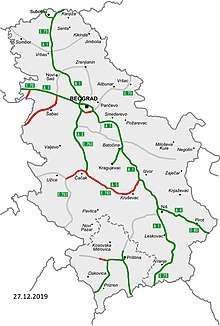
Serbia has a strategic transportation location since the country's backbone, Morava Valley, represents by far the easiest route of land travel from continental Europe to Asia Minor and the Near East.
Serbian road network carries the bulk of traffic in the country. Total length of roads is 45,419 km of which 962 km are "class-IA state roads" (i.e. motorways); 4,517 km are "class-IB state roads" (national roads); 10,941 km are "class-II state roads" (regional roads) and 23,780 km are "municipal roads".[304][305][306] The road network, except for the most of class-IA roads, are of comparatively lower quality to the Western European standards because of lack of financial resources for their maintenance in the last 20 years.
Over 300 kilometers of new motorways has been constructed in the last decade and additional 142 kilometers are currently under construction: A5 motorway (from south of Pojate (north of Kruševac ) to Čačak) and 30 km-long segment of A2 (between Čačak and Požega).[307][308] Coach transport is very extensive: almost every place in the country is connected by bus, from largest cities to the villages; in addition there are international routes (mainly to countries of Western Europe with large Serb diaspora). Routes, both domestic and international, are served by more than hundred intercity coach services, biggest of which are Lasta and Niš-Ekspres. As of 2018, there were 1,999,771 registered passenger cars or 1 passenger car per 3.5 inhabitants.[309]
Serbia has 3,819 kilometres of rail tracks, of which 1,279 are electrified and 283 kilometres are double-track railroad.[170] The major rail hub is Belgrade (and to a lesser degree Niš), while the most important railroads include: Belgrade–Bar (Montenegro), Belgrade–Šid–Zagreb (Croatia)/Belgrade–Niš–Sofia (Bulgaria) (part of Pan-European Corridor X), Belgrade–Subotica–Budapest (Hungary) and Niš–Thessaloniki (Greece). Although still a major mode of freight transportation, railroads face increasing problems with the maintenance of the infrastructure and lowering speeds. Rail services are operated Srbija Voz (passenger transport) and Srbija Kargo (freight transport).[310]
There are only two airports with regular passenger traffic. Belgrade Nikola Tesla Airport served 5.6 million passengers in 2018 and is a hub of flagship carrier Air Serbia which flies to 59 destinations in 32 countries and carried some 2.5 million passengers in 2018.[311][312] Niš Constantine the Great Airport is mainly catering low-cost airlines.[313]
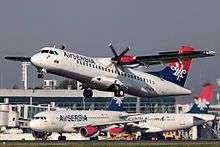
Serbia has a developed inland water transport since there are 1,716 kilometres of navigable inland waterways (1,043 km of navigable rivers and 673 km of navigable canals), which are almost all located in northern third of the country.[170] The most important inland waterway is the Danube (part of Pan-European Corridor VII). Other navigable rivers include Sava, Tisza, Begej and Timiş River, all of which connect Serbia with Northern and Western Europe through the Rhine–Main–Danube Canal and North Sea route, to Eastern Europe via the Tisza, Begej and Danube Black Sea routes, and to Southern Europe via the Sava river. More than 2 million tonnes of cargo were transported on Serbian rivers and canals in 2016 while the largest river ports are: Novi Sad, Belgrade, Pančevo, Smederevo, Prahovo and Šabac.[170][314]
Telecommunications
Fixed telephone lines connect 81% of households in Serbia, and with about 9.1 million users the number of cellphones surpasses the total population of by 28%.[315] The largest mobile operator is Telekom Srbija with 4.2 million subscribers, followed by Telenor with 2.8 million users and Vip mobile with about 2 million.[315] Some 58% of households have fixed-line (non-mobile) broadband Internet connection while 67% are provided with pay television services (i.e. 38% cable television, 17% IPTV, and 10% satellite).[315] Digital television transition has been completed in 2015 with DVB-T2 standard for signal transmission.[316][317]
Tourism
Serbia is not a mass-tourism destination but nevertheless has a diverse range of touristic products.[318] In 2019, total of over 3.6 million tourists were recorded in accommodations, of which half were foreign.[319] Foreign exchange earnings from tourism were estimated at $1.5 billion.[320]
Tourism is mainly focused on the mountains and spas of the country, which are mostly visited by domestic tourists, as well as Belgrade and, to a lesser degree, Novi Sad, which are preferred choices of foreign tourists (almost two-thirds of all foreign visits are made to these two cities).[321][322] The most famous mountain resorts are Kopaonik, Stara Planina and Zlatibor. There are also many spas in Serbia, the biggest of which are Vrnjačka Banja, Soko Banja, and Banja Koviljača. City-break and conference tourism is developed in Belgrade and Novi Sad.[323] Other touristic products that Serbia offer are natural wonders like Đavolja varoš,[324] Christian pilgrimage to the many Orthodox monasteries across the country and the river cruising along the Danube. There are several internationally popular music festivals held in Serbia, such as EXIT (with 25–30,000 foreign visitors coming from 60 different countries) and the Guča trumpet festival.[325]
Education and science
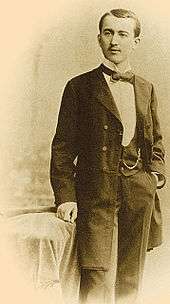
According to 2011 census, literacy in Serbia stands at 98% of population while computer literacy is at 49% (complete computer literacy is at 34.2%).[327] Same census showed the following levels of education: 16.2% of inhabitants have higher education (10.6% have bachelors or master's degrees, 5.6% have an associate degree), 49% have a secondary education, 20.7% have an elementary education, and 13.7% have not completed elementary education.[328]
Education in Serbia is regulated by the Ministry of Education and Science. Education starts in either preschools or elementary schools. Children enroll in elementary schools at the age of seven. Compulsory education consists of eight grades of elementary school. Students have the opportunity to attend gymnasiums and vocational schools for another four years, or to enroll in vocational training for 2 to 3 years. Following the completion of gymnasiums or vocational schools, students have the opportunity to attend university.[329] Elementary and secondary education are also available in languages of recognised minorities in Serbia, where classes are held in Hungarian, Slovak, Albanian, Romanian, Rusyn, Bulgarian as well as Bosnian and Croatian languages. Petnica Science Center is a notable institution for extracurricular science education focusing on gifted students.[330]
There are 19 universities in Serbia (nine public universities with a total number of 86 faculties and ten private universities with 51 faculties).[331] In 2018/2019 academic year, 210,480 students attended 19 universities (181,310 at public universities and some 29,170 at private universities) while 47,169 attended 81 "higher schools".[170][332] Public universities in Serbia are: the University of Belgrade (oldest, founded in 1808, and largest university with 97,696 undergraduates and graduates[332]), University of Novi Sad (founded in 1960 and with student body of 42,489),[332] University of Niš (founded in 1965; 20,559 students),[332] University of Kragujevac (founded in 1976; 14,053 students), University of Priština (located in North Mitrovica), Public University of Novi Pazar as well as three specialist universities – University of Arts, University of Defence and University of Criminal Investigation and Police Studies. Largest private universities include Megatrend University and Singidunum University, both in Belgrade, and Educons University in Novi Sad. The University of Belgrade (placed in 301–400 bracket on 2013 Shanghai Ranking of World Universities, being best-placed university in Southeast Europe after those in Athens and Thessaloniki) and University of Novi Sad are generally considered as the best institutions of higher learning in the country.[333]
.jpg)
Serbia spent 0.9% of GDP on scientific research in 2017, which is slightly below the European average.[334] Since 2018, Serbia is a full member of CERN.[335][336] Serbia has a long history of excellence in maths and computer sciences which has created a strong pool of engineering talent, although economic sanctions during the 1990s and chronic underinvestment in research forced many scientific professionals to leave the country.[337] Nevertheless, there are several areas in which Serbia still excels such as growing information technology sector, which includes software development as well as outsourcing. It generated over $1.2 billion in exports in 2018, both from international investors and a significant number of dynamic homegrown enterprises.[338] Serbia is one of the countries with the highest proportion of women in science.[339] Among the scientific institutes operating in Serbia, the largest are the Mihajlo Pupin Institute and Vinča Nuclear Institute, both in Belgrade. The Serbian Academy of Sciences and Arts is a learned society promoting science and arts from its inception in 1841.[340] With a strong science and technological ecosystem, Serbia has produced a number of renowned scientists that have greatly contributed to the field of science and technology.[341]
Culture
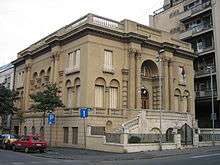
For centuries straddling the boundaries between East and West, the territory of Serbia had been divided among the Eastern and Western halves of the Roman Empire; then between Byzantium and the Kingdom of Hungary; and in the Early modern period between the Ottoman Empire and the Habsburg Empire. These overlapping influences have resulted in cultural varieties throughout Serbia; its north leans to the profile of Central Europe, while the south is characteristic of the wider Balkans and even the Mediterranean. The Byzantine influence on Serbia was profound, firstly through the introduction of Eastern Christianity in the Early Middle Ages. The Serbian Orthodox Church has had an enduring status in Serbia, with the many Serbian monasteries constituting cultural monuments left from Serbia in the Middle Ages. Serbia has seen influences of Republic of Venice as well, mainly though trade, literature and romanesque architecture.[344][345]
Serbia has five cultural monuments inscribed in the list of UNESCO World Heritage: the early medieval capital Stari Ras and the 13th-century monastery Sopoćani; the 12th-century Studenica monastery; the Roman complex of Gamzigrad–Felix Romuliana; medieval tombstones Stećci; and finally the endangered Medieval Monuments in Kosovo (the monasteries of Visoki Dečani, Our Lady of Ljeviš, Gračanica and Patriarchal Monastery of Peć).[346]
There are two literary monuments on UNESCO's Memory of the World Programme: the 12th-century Miroslav Gospel, and scientist Nikola Tesla's archive. The slava (patron saint veneration), kolo (traditional folk dance) and singing to the accompaniment of the gusle are inscribed on UNESCO Intangible Cultural Heritage Lists. The Ministry of Culture and Information is tasked with preserving the nation's cultural heritage and overseeing its development. Further activities supporting development of culture are undertaken at local government level.
Art and architecture
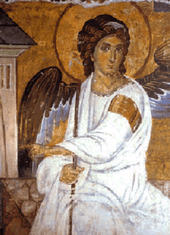
Traces of Roman and early Byzantine Empire architectural heritage are found in many royal cities and palaces in Serbia, like Sirmium, Felix Romuliana and Justiniana Prima, since 535 the seat of the Archbishopric of Justiniana Prima.[348]
Serbian monasteries are the pinnacle of Serbian medieval art. At the beginning, they were under the influence of Byzantine Art which was particularly felt after the fall of Constantinople in 1204, when many Byzantine artists fled to Serbia. Noted of these monasteries is Studenica (built around 1190). It was a model for later monasteries, like the Mileševa, Sopoćani, Žiča, Gračanica and Visoki Dečani. Numerous monuments and cultural sites were destroyed at various stages of Serbian history, with destruuction in Kosovo being the recent example. In the end of 14th and the 15th centuries, autochthonous architectural style known as Morava style evolved in area around Morava Valley. A characteristic of this style was the wealthy decoration of the frontal church walls. Examples of this include Manasija, Ravanica and Kalenić monasteries.
Icons and fresco paintings are often considered the peak of Serbian art. The most famous frescos are White Angel (Mileševa monastery), Crucifixion (Studenica monastery) and Dormition of the Virgin (Sopoćani).[349]
Country is dotted with many well-preserved medieval fortifications and castles such as Smederevo Fortress (largest lowland fortress in Europe),[350] Golubac, Maglič, Soko grad, Belgrade Fortress, Ostrvica and Ram.
During the time of Ottoman occupation, Serbian art was virtually non-existent, with the exception of several Serbian artists who lived in the lands ruled by the Habsburg Monarchy. Traditional Serbian art showed Baroque influences at the end of the 18th century as shown in the works of Nikola Nešković, Teodor Kračun, Zaharije Orfelin and Jakov Orfelin.[351]
.jpg)
Serbian painting showed the influence of Biedermeier and Neoclassicism as seen in works by Konstantin Danil,[352] Arsenije Teodorović and Pavel Đurković.[353] Many painters followed the artistic trends set in the 19th century Romanticism, notably Đura Jakšić, Stevan Todorović, Katarina Ivanović and Novak Radonić.[354][355]
Important Serbian painters of the first half of the 20th century were Paja Jovanović and Uroš Predić of Realism, Cubist Sava Šumanović, Milena Pavlović-Barili and Nadežda Petrović of Impressionism, Expressionist Milan Konjović. Noted painters of the second half of 20th century include Marko Čelebonović, Petar Lubarda, Milo Milunović, Ljubomir Popović and Vladimir Veličković.[356]
Anastas Jovanović was one of the earliest photographes in the world, while Marina Abramović is one of the world leading performance artists. Pirot carpet is known as one of the most important traditional handicrafts in Serbia.[357][358]
There are around 180 museums in Serbia,[359] of which the most prominent is the National Museum of Serbia, founded in 1844. It houses one of the largest art collections in the Balkans, including many foreign masterpiece collections.[360] Other art museums of note are Museum of Contemporary Art in Belgrade, Museum of Vojvodina and the Gallery of Matica Srpska in Novi Sad.
Literature
The beginning of Serbian literacy dates back to the activity of the brothers Cyril and Methodius in the Balkans. Monuments of Serbian literacy from the early 11th century can be found, written in Glagolitic. Starting in the 12th century, books were written in Cyrillic. From this epoch, the oldest Serbian Cyrillic book editorial are the Miroslav Gospels from 1186. The Miroslav Gospels are considered to be the oldest book of Serbian medieval history and as such has entered UNESCO's Memory of the World Register.[361]
Notable medieval authors include Saint Sava, Jefimija, Stefan Lazarević, Constantine of Kostenets and others.[362] Due to Ottoman occupation, when every aspect of formal literacy stopped, Serbia stayed excluded from the entire Renaissance flow in Western culture. However, the tradition of oral story-telling blossomed, shaping itself through epic poetry inspired by at the times still recent Kosovo battle and folk tales deeply rooted in Slavic mythology. Serbian epic poetry in those times has seen as the most effective way in preserving the national identity.[363][364] The oldest known, entirely fictional poems, make up the Non-historic cycle; this one is followed by poems inspired by events before, during and after Kosovo Battle. The special cycles are dedicated to Serbian legendary hero, Marko Kraljević, then about hajduks and uskoks, and the last one dedicated to the liberation of Serbia in the 19th century. Some of the best known folk ballads are The Death of the Mother of the Jugović Family and The Mourning Song of the Noble Wife of the Asan Aga (1646), translated into European languages by Goethe, Walter Scott, Pushkin and Mérimée. One of the most notable tales from Serbian folklore is The Nine Peahens and the Golden Apples.[365]

Baroque trends in Serbian literature emerged in the late 17th century. Notable Baroque-influenced authors were Gavril Stefanović Venclović, Jovan Rajić, Zaharije Orfelin, Andrija Zmajević and others.[366] Dositej Obradović was a prominent figure of the Age of Enlightenment, while the notable Classicist writer was Jovan Sterija Popović, although his works also contained elements of Romanticism.[367] In the era of national revival, in the first half of the 19th century, Vuk Stefanović Karadžić collected Serbian folk literature, and reformed the Serbian language and spelling,[368] paving the way for Serbian Romanticism. The first half of the 19th century was dominated by Romanticism, with Petar II Petrović-Njegoš, Branko Radičević, Đura Jakšić, Jovan Jovanović Zmaj and Laza Kostić being the notable representatives, while the second half of the century was marked by Realist writers such as Milovan Glišić, Laza Lazarević, Simo Matavulj, Stevan Sremac, Vojislav Ilić, Branislav Nušić, Radoje Domanović and Borisav Stanković.
The 20th century was dominated by the prose writers Meša Selimović (Death and the Dervish), Miloš Crnjanski (Migrations), Isidora Sekulić (The Cronicle of a Small Town Cemetery), Branko Ćopić (Eagles Fly Early), Borislav Pekić (The Time of Miracles), Danilo Kiš (The Encyclopedia of the Dead), Dobrica Ćosić (The Roots), Aleksandar Tišma (The Use of Man), Milorad Pavić and others.[369][370] Notable poets include Milan Rakić, Jovan Dučić, Vladislav Petković Dis, Rastko Petrović, Stanislav Vinaver, Dušan Matić, Branko Miljković, Vasko Popa, Oskar Davičo, Miodrag Pavlović, and Stevan Raičković.[371]
Pavić is widely acclaimed Serbian author of the beginning of the 21st century, most notably for his Dictionary of the Khazars, which has been translated into 38 languages.[372] Notable contemporary authors include David Albahari, Svetislav Basara, Goran Petrović, Gordana Kuić, Vuk Drašković and Vladislav Bajac. Serbian comics emerged in the 1930s and the medium remains popular today.
Ivo Andrić (The Bridge on the Drina) is possibly the best-known Serbian author;[373] he was awarded the Nobel Prize in Literature in 1961. The most beloved face of Serbian literature was Desanka Maksimović, who for seven decades remained the leading lady of Yugoslav poetry.[374][375][376][377][378] She is honoured with statues, postage stamps, and the names of streets across Serbia.[379][380][379][381]
There are 551 public libraries biggest of which are: National Library of Serbia in Belgrade with funds of about 6 million items,[382] and Matica Srpska (the oldest matica and Serbian cultural institution, founded in 1826) in Novi Sad with nearly 3.5 million volumes.[383][384] In 2010, there were 10,989 books and brochures published.[170] The book publishing market is dominated by several major publishers such as Laguna and Vulkan (both of which operate their own bookstore chains) and the industry's centrepiece event, annual Belgrade Book Fair, is the most visited cultural event in Serbia with 158,128 visitors in 2013.[385] The highlight of the literary scene is awarding of NIN Prize, given every January since 1954 for the best newly published novel in Serbian language.[386][387]
Music
Composer and musicologist Stevan Stojanović Mokranjac is considered the founder of modern Serbian music.[388][389] The Serbian composers of the first generation Petar Konjović, Stevan Hristić, and Miloje Milojević maintained the national expression and modernised the romanticism into the direction of impressionism.[390][391] Other famous classical Serbian composers include Isidor Bajić, Stanislav Binički and Josif Marinković.[392][393] There are three opera houses in Serbia: Opera of the National Theatre and Madlenianum Opera, both in Belgrade, and Opera of the Serbian National Theatre in Novi Sad. Four symphonic orchestra operate in the country: Belgrade Philharmonic Orchestra, Niš Symphony Orchestra, Symphonic Orchestra of Radio Television of Serbia, and Novi Sad Philharmonic Orchestra. The Choir of Radio Television of Serbia is a leading vocal ensemble in the country.[394] The BEMUS is one of the most prominent classical music festivals in the South East Europe.
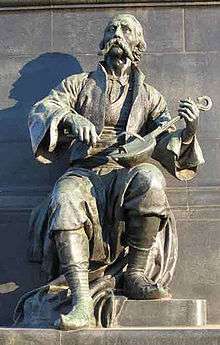
Traditional Serbian music includes various kinds of bagpipes, flutes, horns, trumpets, lutes, psalteries, drums and cymbals. The kolo is the traditional collective folk dance, which has a number of varieties throughout the regions. The most popular are those from Užice and Morava region. Sung epic poetry has been an integral part of Serbian and Balkan music for centuries. In the highlands of Serbia these long poems are typically accompanied on a one-string fiddle called the gusle, and concern themselves with themes from history and mythology. There are records of gusle being played at the court of the 13th-century King Stefan Nemanjić.[395]
Pop music has mainstream popularity. Željko Joksimović won second place at the 2004 Eurovision Song Contest and Marija Šerifović managed to win the 2007 Eurovision Song Contest with the song "Molitva", and Serbia was the host of the 2008 edition of the contest. Most popular pop singers include likes of Đorđe Balašević, Goca Tržan, Zdravko Čolić, Aleksandra Radović, Vlado Georgiev, Jelena Tomašević and Nataša Bekvalac among others.
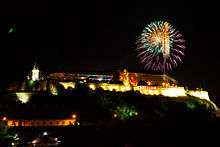
The Serbian rock which was during the 1960s, 1970s and 1980s part of former Yugoslav rock scene, used to be well developed and covered in the media. During the 1990s and 2000s popularity of rock music declined in Serbia,[397] and although several major mainstream acts managed to sustain their popularity, an underground and independent music scene developed.[398] The 2000s saw a revival of the mainstream scene and the appearance of a large number of notable acts. Notable Serbian rock acts include Bajaga i Instruktori, Disciplina Kičme, Ekatarina Velika, Električni Orgazam, Eva Braun, Kerber, Neverne Bebe, Partibrejkers, Ritam Nereda, Orthodox Celts, Rambo Amadeus, Riblja Čorba, S.A.R.S., Smak, Van Gogh, YU Grupa and others.
Folk music in its original form has been a prominent music style since World War One following the early success of Sofka Nikolić. The music has been further promoted by Danica Obrenić, Anđelija Milić, Nada Mamula, and even later, during 60s and 70s, with stars like Silvana Armenulić, Toma Zdravković, Lepa Lukić, Vasilija Radojčić, Vida Pavlović and Gordana Stojićević.
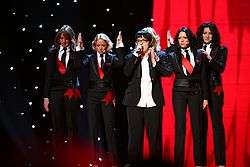
Turbo-folk music is subgenre that has developed in Serbia in the late 1980s and the beginning of the 1990s[400] and has since enjoyed an immense popularity[401] through acts of Dragana Mirković, Zorica Brunclik, Šaban Šaulić, Ana Bekuta, Sinan Sakić, Vesna Zmijanac, Mile Kitić, Snežana Đurišić, Šemsa Suljaković, and Nada Topčagić. It is a blend of folk music with pop and/or dance elements and can be seen as a result of the urbanisation of folk music. In recent period turbo-folk featured even more pop music elements, and some of the performers were labeled as pop-folk. The most famous among them are Ceca (often considered to be the biggest music star of Serbia[402]), Jelena Karleuša,[403] Aca Lukas, Seka Aleksić, Dara Bubamara, Indira Radić, Saša Matić, Viki Miljković, Stoja and Lepa Brena, arguably the most prominent performer of former Yugoslavia.[404]
Balkan Brass, or truba ("trumpet") is a popular genre, especially in Central and Southern Serbia where Balkan Brass originated. The music has its tradition from the First Serbian Uprising. The trumpet was used as a military instrument to wake and gather soldiers and announce battles, the trumpet took on the role of entertainment during downtime, as soldiers used it to transpose popular folk songs. When the war ended and the soldiers returned to the rural life, the music entered civilian life and eventually became a music style, accompanying births, baptisms, weddings, and funerals. There are two main varieties of this genre, one from Western Serbia and the other from Southern Serbia, with brass musician Boban Marković being one of the most respected names in the world of modern brass band bandleaders.[405]
Most popular music festival are Guča Trumpet Festival with over 300,000 annual visitors and EXIT in Novi Sad (won the Best Major Festival award at the European Festivals Awards for 2013 and 2017.) with 200,000 visitors in 2013.[406][407] Other festivals include Nišville Jazz Festival in Niš and Gitarijada rock festival in Zaječar.
Theatre and cinema
Serbia has a well-established theatrical tradition with Joakim Vujić considered the founder of modern Serbian theatre.[408] Serbia has 38 professional theatres and 11 theatres for children,[409] the most important of which are National Theatre in Belgrade, Serbian National Theatre in Novi Sad, National Theatre in Subotica, National Theatre in Niš and Knjaževsko-srpski teatar in Kragujevac (the oldest theatre in Serbia, established in 1835). The Belgrade International Theatre Festival – BITEF, founded in 1967, is one of the oldest theatre festivals in the world, and it has become one of the five biggest European festivals.[410][411] Sterijino pozorje is, on the other hand, festival showcasing national drama plays. The most important Serbian playwrighters were Jovan Sterija Popović and Branislav Nušić, while recent renowned names are Dušan Kovačević and Biljana Srbljanović.[412]
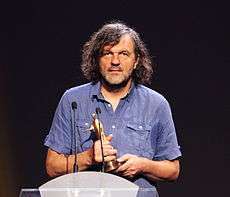
The foundation of Serbian cinema dates back to 1896 with the release of the oldest movie in the Balkans, The Life and Deeds of the Immortal Vožd Karađorđe, a biopic about Serbian revolutionary leader, Karađorđe.[413][414]
Serbian cinema is one of the dynamic smaller European cinematographies. Serbia's film industry is heavily subsidised by the government, mainly through grants approved by the Film Centre of Serbia.[415] As of 2011, there were 17 domestic feature films produced.[416] There are 22 operating cinemas in the country, of which 12 are multiplexes, with total attendance exceeding 2.6 million and comparatively high percentage of 32.3% of total sold tickets for domestic films.[417][418] Modern PFI Studios located in Šimanovci is nowadays Serbia's only major film studio complex; it consists of 9 sound stages and attracts mainly international productions, primarily American and West European.[419] The Yugoslav Film Archive used to be former Yugoslavia's and now is Serbia national film archive – with over 100 thousand film prints, it is among five largest film archives in the world.[420][421]
Famous Serbian filmmaker Emir Kusturica won two Golden Palms for Best Feature Film at the Cannes Film Festival, for When Father Was Away on Business in 1985 and then again for Underground in 1995.[422] Other renowned directors include Dušan Makavejev, Želimir Žilnik (Golden Berlin Bear winner), Aleksandar Petrović, Živojin Pavlović, Goran Paskaljević, Goran Marković, Srđan Dragojević, Srdan Golubović and Mila Turajlić among others. Serbian-American screenwriter Steve Tesich won the Academy Award for Best Original Screenplay in 1979 for the movie Breaking Away.
Prominent movie stars in Serbia have left celebrated heritage in cinematography of Yugoslavia as well. Notable mentions are Zoran Radmilović, Pavle Vuisić, Ljubiša Samardžić, Olivera Marković, Mija Aleksić, Miodrag Petrović Čkalja, Ružica Sokić, Velimir Bata Živojinović, Danilo Bata Stojković, Seka Sablić, Olivera Katarina, Dragan Nikolić, Mira Stupica, Nikola Simić, Bora Todorović and others. Milena Dravić was one of the most celebrated actress in Serbian cinematography.[423] She has won Best Actress Award on Cannes Film Festival in 1980.[424]
Media
The freedom of the press and the freedom of speech are guaranteed by the constitution of Serbia.[425] Serbia is ranked 90th out of 180 countries in the 2019 Press Freedom Index report compiled by Reporters Without Borders.[426] Report noted that media outlets and journalists continue to face partisan and government pressure over editorial policies. Also, the media are now more heavily dependent on advertising contracts and government subsidies to survive financially.[427]
According to AGB Nielsen Research in 2009, Serbs on average watch five hours of television per day, making it the highest average in Europe.[430] There are seven nationwide free-to-air television channels, with public broadcaster Radio Television of Serbia (RTS) operating three (RTS1, RTS2 and RTS3) and private broadcasters operating four (Pink, Happy, Prva, and O2). In 2017, preferred usage of these channels were as follows: 20.2% for RTS1, 14.1% for Pink, 9.4% for Happy, 9.0% for Prva, 4.7% for O2, and 2.5% for RTS2.[431] There are 28 regional television channels and 74 local television channels.[170] Besides terrestrial channels there are dozens Serbian television channels available only on cable or satellite.
There are 247 radio stations in Serbia.[170] Out of these, six are radio stations with national coverage, including two of public broadcaster Radio Television of Serbia (Radio Belgrade 1 and Radio Belgrade 2/Radio Belgrade 3) and four private ones (Radio S1, Radio S2, Play Radio, and Radio Hit FM). Also, there are 34 regional stations and 207 local stations.[432]
There are 305 newspapers published in Serbia[433] of which 12 are daily newspapers. Dailies Politika and Danas are Serbia's papers of record, former being the oldest newspaper in the Balkans, founded in 1904.[434] Highest circulation newspapers are tabloids Večernje Novosti, Blic, Kurir, and Informer, all with more than 100,000 copies sold.[435] There are one daily newspaper devoted to sports – Sportski žurnal, one business daily Privredni pregled, two regional newspapers (Dnevnik published in Novi Sad and Narodne novine from Niš), and one minority-language daily (Magyar Szo in Hungarian, published in Subotica).
There are 1,351 magazines published in the country.[433] Those include weekly news magazines NIN, Vreme and Nedeljnik, popular science magazine of Politikin Zabavnik, women's Lepota & Zdravlje, auto magazine SAT revija, IT magazine Svet kompjutera. In addition, there is a wide selection of Serbian editions of international magazines, such as Cosmopolitan, Elle, Men's Health, National Geographic, Le Monde diplomatique, Playboy, and Hello!, among others.
The main news agencies are Tanjug, Beta and Fonet.
As of 2017, out of 432 web-portals (mainly on the .rs domain)[436] the most visited are online editions of printed dailies Blic and Kurir, news web-portal B92, and classifieds KupujemProdajem.[437]
Cuisine
Serbian cuisine is largely heterogeneous in a way characteristic of the Balkans and, especially, the former Yugoslavia. It features foods characteristic of lands formerly under Turkish suzerainty as well as cuisine originating from other parts of Central Europe (especially Austria and Hungary). Food is very important in Serbian social life, particularly during religious holidays such as Christmas, Easter and feast days i.e. slava.[438]
Staples of the Serbian diet include bread, meat, fruits, vegetables, and dairy products. Bread is the basis of all Serbian meals, and it plays an important role in Serbian cuisine and can be found in religious rituals. A traditional Serbian welcome is to offer bread and salt to guests. Meat is widely consumed, as is fish. Serbian specialties include ćevapčići (caseless sausages made of minced meat, which is always grilled and seasoned), pljeskavica, sarma, kajmak (a dairy product similar to clotted cream), gibanica (cheese and kajmak pie), ajvar (a roasted red pepper spread), proja (cornbread), and kačamak (corn-flour porridge).[439]
Serbians claim their country as the birthplace of rakia (rakija), a highly alcoholic drink primarily distilled from fruit. Rakia in various forms is found throughout the Balkans, notably in Bulgaria, Croatia, Slovenia, Montenegro, Hungary and Turkey. Slivovitz (šljivovica), a plum brandy, is a type of rakia which is considered the national drink of Serbia.[440]
Winemaking traditions in Serbia dates back to Roman times.[441] Serbian wines are produced in 22 different geographical regions, with white wine dominating the total amount.[442] Besides rakia and beer, wine is a very popular alcoholic beverage in the country.
Sports
Sports play an important role in Serbian society, and the country has a strong sporting history. The most popular sports in Serbia are football, basketball, tennis, volleyball, water polo and handball.
.jpg)
Professional sports in Serbia are organised by sporting federations and leagues (in case of team sports). One of particularities of Serbian professional sports is existence of many multi-sports clubs (called "sports societies"), biggest and most successful of which are Red Star, Partizan, and Beograd in Belgrade, Vojvodina in Novi Sad, Radnički in Kragujevac, Spartak in Subotica.
Football is the most popular sport in Serbia, and the Football Association of Serbia with 146,845 registered players, is the largest sporting association in the country.[443] FK Bačka 1901 is the oldest football club in Serbia and the former Yugoslavia.[444] Dragan Džajić was officially recognised as "the best Serbian player of all times" by the Football Association of Serbia, and more recently the likes of Nemanja Vidić, Dejan Stanković, Branislav Ivanović, Aleksandar Kolarov and Nemanja Matić play for the elite European clubs, developing the nation's reputation as one of the world's biggest exporters of footballers.[445][446] The Serbia national football team lacks relative success although it qualified for three of the last four FIFA World Cups. Serbia national youth football teams have won 2013 U-19 European Championship and 2015 U-20 World Cup. The two main football clubs in Serbia are Red Star (winner of the 1991 European Cup) and Partizan (finalist of the 1966 European Cup), both from Belgrade. The rivalry between the two clubs is known as the "Eternal Derby", and is often cited as one of the most exciting sports rivalries in the world.[447]
.jpg)
Serbia is one of the traditional powerhouses of world basketball,[448][449] as Serbia men's national basketball team have won two World Championships (in 1998 and 2002), three European Championships (1995, 1997, and 2001) and two Olympic silver medals (in 1996 and 2016) as well. The women's national basketball team won the European Championship in 2015 and Olympic bronze medal in 2016. A total of 31 Serbian players have played in the NBA in last three decades, including Nikola Jokić (2019 All-NBA First team), Predrag "Peja" Stojaković (2011 NBA champion and three-time NBA All-Star), and Vlade Divac (2001 NBA All-Star and Basketball Hall of Famer).[450] The renowned "Serbian coaching school" produced many of the most successful European basketball coaches of all times, such as Željko Obradović (who won a record 9 Euroleague titles as a coach), Dušan Ivković, Svetislav Pešić, and Igor Kokoškov (the first coach born and raised outside of North America to be hired as a head coach in the NBA). KK Partizan basketball club was the 1992 European champion.
The Serbia men's national water polo team is the one of the most successful national teams, having won Olympic gold medal in 2016, three World Championships (2005, 2009 and 2015), and seven European Championships in 2001, 2003, 2006, 2012, 2014, 2016 and 2018, respectively.[451] VK Partizan has won a joint-record seven European champion titles.
Recent success of Serbian tennis players has led to an immense growth in the popularity of tennis in the country. Novak Djokovic has won seventeen Grand Slam singles title and has held the No. 1 spot in the ATP rankings for over 270 weeks. He became the eighth player in history to achieve the Career Grand Slam and the third man to hold all four major titles at once and the first ever to do so on three different surfaces.[452] Ana Ivanovic (champion of 2008 French Open) and Jelena Janković were both ranked No. 1 in the WTA Rankings. There were two No. 1 ranked-tennis double players as well: Nenad Zimonjić (three-time men's double and four-time mixed double Grand Slam champion) and Slobodan Živojinović. The Serbia men's tennis national team won the 2010 Davis Cup and 2020 ATP Cup, while Serbia women's tennis national team reached the final at 2012 Fed Cup.[453]
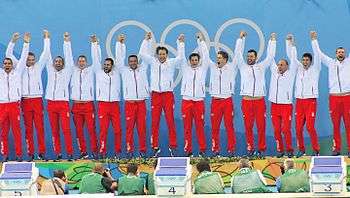
Serbia is one of the leading volleyball countries in the world. Its men's national team won the gold medal at 2000 Olympics, the European Championship three times as well as the 2016 FIVB World League. The women's national volleyball team are current world Champions, has won European Championship three times as well as Olympic silver medal in 2016.
Jasna Šekarić, sport shooter, is one of the athletes with the most appearances at the Olympic Games. She has won a total of five Olympic medals and also three World Championship gold medals. Other noted Serbian athletes include: swimmers Milorad Čavić (2009 World championships gold and silver medalist as well as 2008 Olympic silver medalist on 100-metre butterfly in historic race with American swimmer Michael Phelps) and Nađa Higl (2009 World champion in 200-metre breaststroke); track and field athletes Vera Nikolić (former world record holder in 800 metres) and Ivana Španović (long-jumper; four-time European champion, World indoor champion and bronze medalist at the 2016 Olympics); wrestler Davor Štefanek (2016 Olympic gold medalist and 2014 World champion), and taekwondoist Milica Mandić (2012 Olympic gold medalist and 2017 world champion).
Serbia has hosted several major sport competitions, including the 2005 Men's European Basketball Championship, 2005 Men's European Volleyball Championship, 2006 and 2016 Men's European Water Polo Championships, 2009 Summer Universiade, 2012 European Men's Handball Championship, and 2013 World Women's Handball Championship. The most important annual sporting events held in the country are the Belgrade Marathon and the Tour de Serbie cycling race.
Notes
| a. | ^ Kosovo is the subject of a territorial dispute between the Republic of Kosovo and the Republic of Serbia. The Republic of Kosovo unilaterally declared independence on 17 February 2008, but Serbia continues to claim it as part of its own sovereign territory. The two governments began to normalise relations in 2013, as part of the 2013 Brussels Agreement. Kosovo is currently recognized as an independent state by 97 out of the 193 United Nations member states. In total, 112 UN member states recognized Kosovo at some point, of which 15 later withdrew their recognition. |
References
- "The World Factbook: Serbia". Central Intelligence Agency. 20 June 2014. Retrieved 18 December 2014.
- "PBC stats". stat.gov.rs. 2019.
- "World Economic Outlook Database, January 2020". IMF.org. International Monetary Fund. Retrieved 2 March 2020.
- "Gini coefficient of equivalised disposable income – EU-SILC survey". ec.europa.eu. Eurostat. Retrieved 30 March 2020.
- "2019 Human Development Report" (PDF). United Nations Development Programme. 2019. Retrieved 9 December 2019.
- Steven Tötösy de Zepetnek; Louise Olga Vasvári (2011). Comparative Hungarian Cultural Studies. Purdue University Press. ISBN 9781557535931.
- Calcium and Magnesium in Groundwater: Occurrence and Significance for Human Health – Serbia. Lidia Razowska-Jaworek, CRC Press. 2014. ISBN 9781315764160. Retrieved 3 June 2017.
- "Official population projection for Serbia (2016)". Republic of Serbia Statistical Bureau. Archived from the original on 2 February 2016. Retrieved 7 January 2016.
- The Age of Nepotism: Travel Journals and Observations from the Balkans. Vahid Razavi. 2009. ISBN 9780615274331. Retrieved 3 June 2017.
- "The Serbian Revolution and the Serbian State". Steven W. Sowards, Michigan State University Libraries. 11 June 2009. Retrieved 28 April 2010.
- "Yugoslav Agreement on Succession Issues (2001)". 3 October 2010. Archived from the original on 26 May 2012. Retrieved 14 June 2012.
- "FR Yugoslavia Investment Profile 2001" (PDF). EBRD Country Promotion Programme. p. 3. Archived from the original (PDF) on 28 September 2011.
- "Slovakia's national minority makes Serbia nicer, richer". srbija.gov.rs. 11 December 2018.
- Lux, Gábor; Horváth, Gyula (2017). The Routledge Handbook to Regional Development in Central and Eastern Europe. Taylor & Francis. p. 190.
- Filep, Béla (2016). The Politics of Good Neighbourhood: State, civil society and the enhancement of cultural capital in East Central Europe. Taylor & Francis. p. 71.
- "Serbia a few steps away from concluding WTO accession negotiations". WTO News. 13 November 2013. Retrieved 13 November 2013.
- "A credible enlargement perspective for and enhanced EU engagement with the Western Balkans" (PDF). European Commission. 9 February 2018. Retrieved 9 February 2018.
- "Serbia: On the Way to EU Accession". World Bank Group. Retrieved 21 October 2014.
- "Global Launch of 2015 Human Development Report".
- "2017 Social Progress Index". 2017 Social Progress Index.
- "Global Peace Index" (PDF). economicsandpeace.org. 2018.
- Petković 1926, p. 9.
- "Этимология слова серб". DicList.ru. Archived from the original on 11 October 2016.
- Lukaszewicz 1998, p. 132.
- H. Schuster-Šewc. "Порекло и историја етнонима". translation by Тања Петровић.
- "Serbia's rich and hidden Roman history". BBC News. Retrieved 2 February 2020.
- "Traces of Empire: Serbia's Roman Heritage". Balkan Insight. 24 October 2016. Retrieved 2 February 2020.
- Roksandic 2011, p. 186–196.
- Chapman 1981.
- Srejović 1988.
- Mirković 2017, p. 79.
- Kuzmanović & Mihajlović 2015, p. 416-432.
- Ostrogorsky 1956, p. 84.
- Stipčević 1977, p. 76.
- Fine 1991, p. 38, 41.
- Miller 2005, p. 533.
- Dierauer, Isabelle (16 May 2013). Disequilibrium, Polarization, and Crisis Model: An International Relations Theory Explaining Conflict. University Press of America. p. 88. ISBN 978-0-7618-6106-5.
- Moravcsik 1967.
- Sima M. Ćirković, SRBI MEĐU EUROPSKIM NARODIMA,(Serbs) 2008. http://www.mo-vrebac-pavlovac.hr/attachments/article/451/Sima%20%C4%86irkovi%C4%87%20SRBI%20ME%C4%90U%20EVROPSKIM%20NARODIMA.pdf #page=26-27
- Scholz 1970, p. 111.
- Ćirković 2004, p. 107-108.
- A ́goston & Masters 2010, p. 383.
- Riley-Smith 2001, p. 251.
- Rodriguez 1997, p. 6.
- Kia 2011, p. 62.
- Ćirković 2004, p. 134.
- Ćirković 2004, p. 135-136.
- Fotić 2008, p. 519–520.
- Sotirović 2011, p. 143–169.
- Runciman 1968, p. 204.
- Kia 2011, p. 115.
- Ćirković 2004, p. 115, 119.
- Ćirković 2004, p. 141–142.
- Sotirović 2011, p. 163–164.
- Pešalj 2010, p. 29-42.
- Ćirković 2004, p. 151.
- Todorović 2006, p. 7–8.
- Ćirković 2004, p. 150.
- Jelavich 1983a, p. 94.
- Ćirković 2004, p. 177.
- Ćirković 2004, p. 176.
- Jelavich 1983a, p. 193-204.
- Pavlowitch 2002, p. 29-32.
- Radosavljević 2010, p. 171-178.
- Rajić 2010, p. 143-148.
- Ćirković 2004, p. 179-183.
- Ćirković 2004, p. 190-196.
- Ćirković 2004, p. 191.
- Stavrianos 2000, p. 248–250.
- Ćirković 2004, p. 195.
- "Statehood Day of the Republic of Serbia 2019". School of Engineering Management (Belgrade). Retrieved 12 February 2020.
- Ćirković 2004, p. 214-215.
- Jelavich 1983a, p. 246.
- Pavlowitch 2002, p. 58.
- Pavlowitch 2002, p. 63-64.
- Ćirković 2004, p. 224.
- Ćirković 2004, p. 225.
- Pavlowitch 2002, p. 70.
- Pavlowitch 2002, p. 73.
- Ćirković 2004, p. 203.
- Hall 2000, p. 135.
- Curtis 1992, p. 28.
- Ćirković 2004, p. 246-247.
- Mitrović 2007, p. 69.
- Mitrović 2007, p. 104.
- Ćirković 2004, p. 250-251.
- 22 August 2009 Michael Duffy (22 August 2009). "First World War.com – Primary Documents – Vasil Radoslavov on Bulgaria's Entry into the War, 11 October 1915". firstworldwar.com. Retrieved 28 April 2010.
- Највећа српска победа: Фронт који за савезнике није био битан (in Serbian)
- "Serbian army, August 1914". Vojska.net. Retrieved 28 April 2010.
- "Tema nedelje: Najveća srpska pobeda: Sudnji rat: POLITIKA". Politika. 14 September 2008. Retrieved 28 April 2010.
- "The Balkan Wars and World War I". Library of Congress Country Studies.
- Тема недеље : Највећа српска победа : Сви српски тријумфи : ПОЛИТИКА (in Serbian)
- Loti, Pierre (30 June 1918). "Fourth of Serbia's population dead". Los Angeles Times. Retrieved 28 April 2010.
- "Asserts Serbians face extinction" (PDF). New York Times. 5 April 1918. Retrieved 14 November 2010.
- Radivojević, Biljana; Penev, Goran (2014). "Demographic losses of Serbia in the first world war and their long-term consequences". Economic Annals. 59 (203): 29–54. doi:10.2298/EKA1403029R.
- Arhiv Jugoslavije - December 1 Act, December 1, 1918
- Bojovi ć , Jovan, Zakonik knjza Danila, Titograd: Istorijski institut Crne Gore, 1982.––––––, Podgori č ka skup š tina 1918: dokumenta , Gornji Milanovac: De č je novine, 1989.
- Pavlowitch 2002, p. 108-109.
- Ćirković 2004, p. 251-252.
- Stavrianos 2000, p. 624.
- Pavlowitch 2008, p. 62.
- Savich, Karl. "The Kragujevac massacre". Archived from the original on 17 December 2012.
- "Massacres and Atrocities of WWII in Eastern Europe". Members.iinet.net.au. Archived from the original on 16 July 2012. Retrieved 17 November 2012.
- Raphael Israeli (4 March 2013). The Death Camps of Croatia: Visions and Revisions, 1941–1945. Transaction Publishers. p. 31. ISBN 978-1-4128-4930-2. Retrieved 12 May 2013.
- "Jewish Heritage Europe – Serbia 2 – Jewish Heritage in Belgrade". Jewish Heritage Europe. Archived from the original on 30 June 2010. Retrieved 28 April 2010.
- "Ustaša". Britannica OnlineEncyclopedia. Britannica.com. Retrieved 28 April 2010.
- Broz, Josip (1945). "Nacionalno pitanje u Jugoslaviji: u svjetlosti narodnooslobodilačke borbe". Zagreb: Naprijed: 11.
Moram ovdje podvući činjenicu da su u redovima naše Narodno-oslbodilačke vojske i partizanskih odreda u Jugoslaviji, od samog početka pa do danas, nalaze u ogromnoj većini baš Srbi, umjesto da to bude obratno.
Cite journal requires|journal=(help) - PM. "Storia del movimento partigiano bulgaro (1941–1944)". Bulgaria – Italia. Retrieved 28 April 2010.
- Žerjavić, Vladimir. Yugoslavia: Manipulations with the Number of Second World War Victims. Croatian Information Centre. ISBN 978-0-919817-32-6.CS1 maint: ref=harv (link)
- Yeomans, Rory (2015). The Utopia of Terror: Life and Death in Wartime Croatia. Boydell & Brewer. p. 18. ISBN 978-1-58046-545-8.CS1 maint: ref=harv (link)
- "Ustasa" (PDF). yadvashem.org. Retrieved 25 June 2018.
- "Genocide of the Serbs". The Combat Genocide Association.
- Tanjug. "Posle rata u Srbiji streljano preko 60.000 civila". Mondo.rs.
- Melissa Katherine Bokovoy, Jill A. Irvine, Carol S. Lilly. State-society relations in Yugoslavia, 1945–1992. Scranton, Pennsylvania, USA: Palgrave Macmillan, 1997. p. 295.
- Melissa Katherine Bokovoy, Jill A. Irvine, Carol S. Lilly. State-society relations in Yugoslavia, 1945–1992. Scranton, Pennsylvania, USA: Palgrave Macmillan, 1997. p. 296.
- Melissa Katherine Bokovoy, Jill A. Irvine, Carol S. Lilly. State-society relations in Yugoslavia, 1945–1992. Scranton, Pennsylvania, USA: Palgrave Macmillan, 1997. p. 301.
- Norris, David A (2008). Belgrade A Cultural History. Oxford University Press. p. 134. ISBN 9780199888498.
- Bilandžić, Vladimir; Dahlmann, Dittmar; Kosanović, Milan (2012). From Helsinki to Belgrade: The First CSCE Follow-up Meeting and the Crisis of Détente. Vandenhoeck & Ruprecht. pp. 163–184. ISBN 9783899719383.
- Trifunović, Vesna (July 2018). "Patterns of competitive authoritarianism in the Western Balkans". Glasnik Etnografskog instituta SANU. 65 (1): 127–145. doi:10.2298/GEI1701127T.
- Magaš, Branka (1993). The Destruction of Yugoslavia: tracking the break-up 1980–92 (pp 165–170). Verso. ISBN 978-0-86091-593-5.
- Engelberg, Stephen (16 January 1992). "Breakup of Yugoslavia Leaves Slovenia Secure, Croatia Shaky". The New York Times. Retrieved 6 April 2010.
- Udovicki, Jasminka; Ridgeway, James (2000). Burn This House: The Making and Unmaking of Yugoslavia. Durham, North Carolina: Duke University Press. pp. 255–266. ISBN 9781136764820.CS1 maint: ref=harv (link)
- Fridman, Orli (2010). "'It was like fighting a war with our own people': anti-war activism in Serbia during the 1990s". The Journal of Nationalism and Ethnicity. 39 (4): 507–522. doi:10.1080/00905992.2011.579953.
- "Political Propaganda and the Plan to Create a "State for all Serbs"" (PDF). Retrieved 14 November 2010.
- Wide Angle, Milosevic and the Media. "Part 3: Dictatorship on the Airwaves." PBS. Quotation from film: "... the things that happened at state TV, warmongering, things we can admit to now: false information, biased reporting. That went directly from Milošević to the head of TV".
- "History, bloody history". BBC News. 24 March 1999. Retrieved 27 July 2012.
- "Serbia home to highest number of refugees and IDPs in Europe". B92. Retrieved 5 May 2020.
- "Serbia: Europe's largest proctracted refugee situation". OSCE. Retrieved 5 May 2020.
- S. Cross, S. Kentera, R. Vukadinovic, R. Nation (7 May 2013). Shaping South East Europe's Security Community for the Twenty-First Century: Trust, Partnership, Integration. Springer. p. 169. ISBN 9781137010209. Retrieved 5 May 2020.CS1 maint: multiple names: authors list (link)
- Ivan Vejvoda, 'Civil Society versus Slobodan Milošević: Serbia 1991–2000', in Adam Roberts and Timothy Garton Ash (eds.), Civil Resistance and Power Politics: The Experience of Non-violent Action from Gandhi to the Present. Oxford & New York: Oxford University Press, 2009, pp. 295–316. ISBN 978-0-19-955201-6.
- Miller 2005, p. 529–581.
- "Montenegro gets Serb recognition". BBC. 15 June 2006.
- "Rift Emerges at the United Nations Over Kosovo". New York Sun. 19 February 2008.
- "NATO offers "intensified dialogue" to Serbia". B92. 3 April 2008. Archived from the original on 11 June 2008. Retrieved 28 April 2010.
- "Republic of Serbia – European Union". Ministry of Foreign Affairs. Archived from the original on 6 May 2013. Retrieved 24 June 2013.
- "EU leaders grant Serbia candidate status". BBC News. 1 March 2012. Retrieved 2 March 2012.
- "Serbia gets EU candidate status, Romania gets nothing". EUobserver. 2 March 2012. Retrieved 24 June 2013.
- "Freedom House ranks Serbia as Partly Free in latest report". N1. 5 February 2019. Retrieved 5 February 2019.
- Voltmer, Katrin (2019). Media, Communication and the Struggle for Democratic Change: Case Studies on Contested Transitions. Springer Nature. p. 6. ISBN 978-3-030-16747-9.
- Bieber, Florian (July 2018). "Patterns of competitive authoritarianism in the Western Balkans". East European Politics. 38 (3): 337–54. doi:10.1080/21599165.2018.1490272.
- Maerz, Seraphine F; et al. (April 2020). "State of the world 2019: autocratization surges – resistance grows". Democratization. doi:10.1080/13510347.2020.1758670.
- Castaldo, Antonino; Pinna, Alessandra (2017). "De-Europeanization in the Balkans. Media freedom in post-Milošević Serbia". European Politics and Society. 19 (3): 264–281. doi:10.1080/23745118.2017.1419599. hdl:10451/30737.
- "The massive protests few people know about". BBC News. Retrieved 20 January 2020.
- "Prvi put policijski čas od Drugog svetskog rata, građani uglavnom poslušni". N1. 19 March 2020.
- "Serbia: Introduction". Michigan State University. Retrieved 3 October 2014.
- "Serbia". Southeastern Europe Travel Guide. Balkans 360. Archived from the original on 6 October 2014. Retrieved 3 October 2014.
- "The World Factbook: Kosovo". Central Intelligence Agency. 19 June 2014. Retrieved 8 January 2015.
- "Border Police Department". Kosovo Police. Retrieved 8 January 2015.
- "Uredba o kontroli prelaska administrativne linije prema Autonomnoj pokrajini Kosovo i Metohija" (in Serbian). Official gazette of the Republic of Serbia. Archived from the original on 8 January 2015. Retrieved 8 January 2015.
- Carevic, Ivana; Jovanovic, Velimir. STRATIGRAPHIC-STRUCTURAL CHARACTERISTICS OF MAČVA BASIN (PDF) (Report). p. 1. UDC 911.2:551.7(497.11). Archived from the original (PDF) on 30 August 2016.
- "About the Carpathians – Carpathian Heritage Society". Carpathian Heritage Society. Archived from the original on 6 April 2010. Retrieved 28 April 2010.
- "O Srbiji". Turistickimagazin.com. Archived from the original on 21 October 2013.
- The Times Atlas of the World (1993). Times Books ISBN 0-7230-0492-7.
- "Serbia :: Climate". Encyclopædia Britannica Online. 2007. pp. 5 of 71.
- "CIA – The World Factbook". Cia.gov. Retrieved 24 May 2012.
- Radovanović, M and Dučić, V, 2002, Variability of Climate in Serbia in the Second Half of the 20th century, EGS XXVII General Assembly, Nice, 21 to 26 April 2002, abstract #2283, 27:2283–, provided by the Smithsonian / NASA Astrophysics Data System
- "Kossava". Glossary of Meteorology, Second Edition. American Meteorological Society. June 2000. Archived from the original on 30 September 2007. Retrieved 11 March 2007.
- "Basic Climate Characteristics for the Territory of Serbia". Hydrometeorological Service of Serbia.
- "Past temperature extremes since the beginning of the measurement" (PDF). Hydrometeorological Service of Serbia. Archived from the original (PDF) on 11 May 2011. Retrieved 5 November 2010.
- "World Risk Report 2013 – Exposure to natural hazards" (PDF). Alliance Development Works. 2013. pp. 3–4. Archived from the original (PDF) on 16 August 2014.
- "River floods Serbia". European Centre for Climate Adaptation. Retrieved 18 December 2014.
- "Serbia gets $300 million from World Bank to aid floods recovery". Reuters. 4 October 2014. Retrieved 18 December 2014.
- "The Danube | National Tourism Organisation of Serbia". www.serbia.travel. Retrieved 27 April 2019.
- Jolović, Dejan (19 August 2016). "Ten economic benefits of the Danube for Serbia". Danubius. Retrieved 27 April 2019.
- Takić, Ljiljana M.; Mladenović-Ranisavljević, Ivana I.; Nikolić, Vesna D.; Nikolić, Ljubiša B.; Vuković, Milovan V.; Živković, Nenad V. (2012). "The assessment of the Danube water quality in Serbia" (PDF). Advanced Technologies: 59.
- "Morava River -". 9 October 2015. Retrieved 27 April 2019.
- "Navigation and Transportation: Waterways". Danube Strategy in Serbia. Retrieved 18 December 2014.
- "Serbia Visit – Nature & Outdoors – Stema Guide". www.serbia-visit.com. Archived from the original on 28 April 2019. Retrieved 28 April 2019.
- "Statistical Yearbook of the Republic of Serbia" (PDF). Statistical Office of the Republic of Serbia. 2012.
- "::SE "Srbijašume" Belgrade". Srbijasume.rs. 31 December 2010. Archived from the original on 22 October 2013. Retrieved 21 October 2013.
- "Serbian biodiversity". IUCN. 7 August 2012. Archived from the original on 26 April 2016. Retrieved 22 August 2019.
- "Reptiles in Serbia" (PDF). Glasnik. 9 June 2017.
- "Serbian Brown Bear". Discoverserbia.org.
- "CARSKA BARA – Fauna ptica". Carskabara.rs. Archived from the original on 23 October 2013. Retrieved 22 October 2013.
- "Uvac Special Nature Reserve". Uvac.org.rs. Archived from the original on 22 October 2013.
- "The largest stationary of longeared owls". serbia.com. 9 June 2017.
- "Earths's Endangered Species". earthsendangered. 9 June 2017.
- "Serbia – European Environment Agency (EEA)". Eea.europa.eu.
- Elezović, Nataša; Stefanov Ketin, Sonja; Dašić, Predrag; Dervišević, Irma (April 2018). "Analysis of SWQI index of the River Ibar (Serbia)". Fresenius Environmental Bulletin.
- "Toxic Taps: Arsenic in Water Stirs Cancer Fears". Balkan Insight. 20 March 2018. Retrieved 28 April 2019.
- "Serbia recycling 15% of waste". Blic. Archived from the original on 29 June 2012. Retrieved 28 April 2010.
- "Environmental impact of the war in Yugoslavia on south-east Europe". assembly.coe.int. Retrieved 20 September 2019.
- "Svi Ustavi moderne države Srbije od 1835 do 2006 - Sretenjski, Turski, Radikalski ustav i Srpska ustavnost". Bašta Balkana Magazin (in Serbian). 29 October 2012. Retrieved 15 August 2019.
- "Sretenjski ustav iz 1835.: Kako je Srbija u 19. stoljeću postala "država slobode" – Liberalni Forum" (in Bosnian). Retrieved 15 August 2019.
- "Serbian Constitutional History Part I". Belgraded.com. Archived from the original on 16 March 2012.
- "Serbia: Constitution of The Republic of Serbia". Wipo.int.
- "Responsibilities". predsednik.rs. Archived from the original on 5 June 2013. Retrieved 20 March 2013.
- "Serbia elects Prime Minister Aleksandar Vucic as president". BBC News. 3 April 2017. Retrieved 16 January 2018.
- "Izbori 2012 – Nova vlada položila zakletvu". B92.
- "National Assembly of the Republic of Serbia | Jurisdiction, competences and duties of the National Assembly". Parlament.gov.rs. 11 June 2008.
- "Rezultati parlamentarnih izbora u Srbiji 2012 – CESID". eIzbori. Archived from the original on 19 October 2013.
- Avramović, Sima (2014). "Srpski građanski zakonik (1844) i pravni transplanti - kopija austrijskog uzora ili više od toga?" (PDF). Srpski Građanski Zakonik - 170 Godina.
- http://www.mreznisistemi.rs, Mrežni Sistemi (5 June 2014). "History of judiciary in Serbia". Supreme Court of Cassation. Archived from the original on 27 April 2019. Retrieved 27 April 2019.
- "Ninkovic Law Office :: News and Publications :: Legal system of Serbia". www.ninkovic.rs. Retrieved 27 April 2019.
- "Zakon o uređenju sudova". Paragraf.rs.
- "Policing in Serbia". POINTPULSE. Retrieved 27 January 2020.
- "About Agency / Security Information Agency". Bia.gov.rs. 27 July 2002. Archived from the original on 20 October 2013. Retrieved 19 October 2013.
- "Serbia Diplomatic List 2012" (PDF). Archived from the original (PDF) on 23 October 2013. Retrieved 27 October 2014.
- "Diplomatic Missions". Ministry of Foreign Affairs of Serbia. Archived from the original on 5 May 2012. Retrieved 24 May 2012.
- "Diplomatic Missions in Serbia". Ministry of Foreign Affairs of Serbia. Archived from the original on 20 February 2012. Retrieved 15 September 2012.
- http://www.mfa.gov.rs/sr/index.php/diplomatsko-konzularna-predstavnistva/diplomatske-misije/ambasade?lang=lat
- "Serbia applies for EU membership". Swedish Presidency of the European Union. Archived from the original on 27 January 2010. Retrieved 25 December 2009.
- "EUROPEAN COUNCIL 27/28 JUNE 2013 CONCLUSIONS" (PDF). Council of the European Union. 27 June 2013. Archived from the original (PDF) on 10 October 2017. Retrieved 28 June 2013.
- "EU grants Serbia candidate status". Times of India. 2 March 2012. Archived from the original on 17 April 2012. Retrieved 24 May 2012.
- EU to map out membership for 6 western Balkan states, Michael Peel and Neil Buckley, Financial Times, 1 February 2018
- Protest conveyed to France, Britain, Costa Rica, Australia, Albania at the Wayback Machine (archive index)
- Резолуција Народне скупштине о заштити суверенитета, територијалног интегритета и уставног поретка Републике Србије // See Article 4.
- Резолуција Народне скупштине о заштити суверенитета, територијалног интегритета и уставног поретка Републике Србије // See Article 6.
- Како је утврђена војна неутралност politika.rs, 12 January 2010.
- "Relations with Serbia".
- NATO "accepts Serbia's determination to be neutral" b92.net, 13 October 2017.
- В зависимости от независимости: Сербия готова разорвать отношения с Западом из-за Косово Archived 3 January 2018 at the Wayback Machine Kommersant, 27 December 2007.
- With Russia as an ally, Serbia edges toward NATO Reuters, 3 July 2016.
- Ramani, Samuel (15 February 2016). "Why Serbia is Strengthening its Alliance with Russia".
- "Više novca za naoružanje". Radio Slobodna Evropa (in Serbo-Croatian). Retrieved 18 January 2019.
- "Vojska Srbije od sutra i zvanično profesionalna". Politika. 31 December 2010. Retrieved 24 May 2012.
- "Blic Online | Sa 28.000 vojnika Vojska Srbije među najbrojnijim u regionu". Blic.rs.
- – Latest information published in Serbia Defense Ministry monthly press "Odbrana" in 1. November 2011 about reserves according to law passed in Serbian parliament. Document contains 20 pages and have information about obligation regarding defending country use of reserve forces and division into active and passive reserve
- "Obveznici postali "pasivna rezerva"" (in Serbian). B92. 4 January 2011. Retrieved 21 June 2013.
- Amnistía Internacional. No hay justicia para las víctimas de los bombardeos de la OTAN. Consultado el 10 de noviembre de 2009.
- Pike, John. "CSTO members". Global Security. Retrieved 21 October 2014.
- "Current multinational operations". www.mod.gov.rs. Retrieved 26 April 2013.
- "Vulin: Izvoz odbrambene industrije 600 miliona dolara u 2018". N1 Srbija (in Serbian). Retrieved 1 August 2019.
- "Srpska vojna industrija u usponu". Glas-javnosti. Archived from the original on 29 June 2012. Retrieved 24 May 2012.
- "Povratak vojne industrije Srbije na svetsku scenu". Blic. Retrieved 24 May 2012.
- "CCRE: Serbia". Archived from the original on 4 June 2012.
- "Law on Territorial Organization" (in Serbian). National Assembly of the Republic of Serbia. 29 December 2007. Archived from the original on 12 October 2013. Retrieved 6 October 2013.
- Hamilton (17 February 2008). "Kosovo declares independence from Serbia". Reuters.
- Decision on the annulment of the illegitimate acts of the provisional institutions of self-government in Kosovo and Metohija on their declaration of unilateral independence Government of Serbia, 2008
- "Попис у Србији 2011". Popis2011.stat.rs.
- "REKOS2011". Esk.rks-gov.net. Archived from the original on 10 November 2013. Retrieved 18 January 2013.
- "Sebičnost žena u Srbiji nije uzrok bele kuge | EurActiv Srbija". Euractiv.rs. 26 July 2013.
- Roser, Max (2014), "Total Fertility Rate around the world over the last centuries", Our World In Data, Gapminder Foundation, archived from the original on 8 July 2019, retrieved 8 May 2019
- "Serbia seeks to fill the '90s brain-drainage gap". EMG.rs. 5 September 2008.
- "Survey S&M 1/2003". Yugoslav Survey.
- "Country Comparison : Population growth rate". The World Factbook, CIA. 2002.
- "Household numbers" (PDF). pod2.stat.gov.rs.
- "Europe Central Asia Economic Update, Spring 2020 : Fighting COVID-19". openknowledge.worldbank.org. World Bank. p. 71, 72. Retrieved 9 April 2020.
- Tanjug (22 October 2007). "Serbia's refugee population largest in Europe". B92.
- "Serbia currently hosts over 260K refugees and IDPs". B92. 20 June 2013. Retrieved 21 June 2013.
- "Slovakia's national minority makes Serbia nicer, richer". srbija.gov.rs. 11 December 2018.
- Lux, Gábor; Horváth, Gyula (2017). The Routledge Handbook to Regional Development in Central and Eastern Europe. Taylor & Francis. p. 190.
- Filep, Béla (2016). The Politics of Good Neighbourhood: State, civil society and the enhancement of cultural capital in East Central Europe. Taylor & Francis. p. 71.
- "Vesti – Zvaničan broj Roma u Srbiji". B92. 7 April 2009.
- Chinese Migrants Use Serbia as Gate to Europe, ABC News, 13 July 2010.
- V. Mijatović – B. Hadžić. "I Kinezi napuštaju Srbiju". Novosti.rs.
- "2011 Census of Population, Households and Dwellings in the Republic of Serbia: Comparative Overview of the Number of Population in 1948, 1953, 1961, 1971, 1981, 1991, 2002 and 2011, Data by settlements" (PDF). Statistical Office of Republic Of Serbia, Belgrade. 2014. ISBN 978-86-6161-109-4. Retrieved 27 June 2014.
- J. Gordon Melton; Baumann, Martin (2010). Religions of the World, Second Edition: A Comprehensive Encyclopedia of Beliefs and Practices. ABC-CLIO. pp. 511–12. ISBN 978-1-59884-204-3. Retrieved 10 October 2016.
- "Становништво, домаћинства и породице – база : Попис у Србији 2011". Popis2011.stat.rs.
- "GRKOKATOLICI U VOJVODINI". Žumberacki Vikarijat. August 2014.
- "Municipality data" (PDF). pod2.stat.gov.rs. PBC.
- Alexander, Ronelle (15 August 2006). Bosnian, Croatian, Serbian, a Grammar: With Sociolinguistic Commentary. Univ of Wisconsin Press. pp. 1–2. ISBN 978-0-299-21193-6.
- "Ivan Klajn: Ćirilica će postati arhaično pismo".
- Subotić, Ljiljana; Sredojević, Dejan; Bjelaković, Isidora (2012), Fonetika i fonologija: Ortoepska i ortografska norma standardnog srpskog jezika (in Serbo-Croatian), FILOZOFSKI FAKULTET NOVI SAD, archived from the original on 3 January 2014
- "Application of the Charter in Serbia" (PDF). European Charter for Regional or Minority Languages. 11 June 2013. pp. 4–5, 9.
- "Upper-middle-income economies". The World Bank.
- "World Economic Outlook Database, April 2019". IMF.org. International Monetary Fund. Retrieved 11 April 2019.
- http://publikacije.stat.gov.rs/G2018/PdfE/G20181271.pdf
- "Belgrade Stock Exchange jsc, Belgrade". belex.rs. Retrieved 5 August 2014.
- "Report for Selected Countries and Subjects: Serbia GDP growth rate". imf.org. Retrieved 5 August 2014.
- "Kako je Srbija došla do javnog duga od 24,8 milijardi evra".
- "Public Debt Administration - Public Debt Stock and Structure".
- http://publikacije.stat.gov.rs/G2019/PdfE/G20195646.pdf
- "Average salaries and wages per employee, May 2019 | Statistical Office of the Republic of Serbia".
- "Europe :: Serbia — the World Factbook - Central Intelligence Agency".
- "US embassy: private sector investments". Archived from the original on 27 May 2010.
- "Ministry of economic relations, Russian Federation".
- "Mining, a new "ace up the sleeve" for Serbia?".
- http://publikacije.stat.gov.rs/G2019/pdfE/G20191198.pdf
- "LIBERALIZED TRADE". siepa.gov.rs. Archived from the original on 29 April 2012. Retrieved 3 August 2014.
- Magazine, E. S. M. "Serbia Becomes World's Top Raspberry Producer". ESM Magazine. Retrieved 28 April 2019.
- "How Serbia Became a Sweet Raspberry Heaven". www.serbia.com. Retrieved 28 April 2019.
- "Privreda u Srbiji". Retrieved 27 October 2014.
- "Izvoz poljoprivrednih proizvoda – 3,2 milijarde dolara". Ekonomski Online.
- "Food". Archived from the original on 9 October 2014. Retrieved 27 October 2014.
- "Agriculture". Government of Serbia. Archived from the original on 16 June 2013. Retrieved 19 March 2013.
- "Serbia Overview". Food and Agriculture Organization of the United Nations. Retrieved 14 June 2013.
- "NATO's Latest Target: Yugoslavia's Economy".
- "Deindustrijalizacija Srbije – Kolumne". AKTER. 28 April 2013. Archived from the original on 29 October 2013.
- Mikavica, A. (3 September 2017). "Slobodne zone mamac za investitore". politika.rs (in Serbian). Retrieved 17 March 2019.
- "Biz – Vesti – Auto-industrija za Srbiju kao IT". B92. 4 October 2013.
- Incredible rise of Serbian steel industry | | Central European Financial Observer
- "All about the Tesla Telephone". telegraf.rs.
- "Serbian Development Agency – RAS" (PDF). siepa.gov.rs.
- "Electronics". Siepa.gov.rs.
- "Pharmaceutical". Siepa.gov.rs.
- "Monitoring of the Iron Gate Hydropower and Navigation System on the Danube River". www.wrmjournal.com. Retrieved 28 April 2019.
- "Biz – Vesti – Srbija ima uglja za još jedan vek". B92.
- "Archived copy" (PDF). Archived from the original (PDF) on 24 August 2013. Retrieved 20 August 2013.CS1 maint: archived copy as title (link)
- Archived 9 March 2013 at the Wayback Machine
- "Exploration, production pace faster in Serbia, Bosnia and Herzegovina – Oil & Gas Journal". Ogj.com.
- "Archived copy". Archived from the original on 24 September 2017. Retrieved 8 May 2017.CS1 maint: archived copy as title (link)
- "Sectors >> Energy Sector .:: Italy-Serbia: Enhancing Entrepreneurial Development" (in Italian). Forumserbia.eu. 6 March 2012. Archived from the original on 29 October 2013.
- "TENT – Responsibility and Privilege". Tent.rs. Archived from the original on 29 October 2013. Retrieved 25 October 2013.
- "HE Đerdap 1 – Tehničke karakteristike". Djerdap.rs. Archived from the original on 25 October 2013.
- "Serbia Energy Business Magazine – Energy Sector Serbia". Serbia-energy.eu.
- "НИС у бројкама | НИС". Nis.rs. Archived from the original on 29 October 2013. Retrieved 25 October 2013.
- "Practical Law". Uk.practicallaw.com. 1 February 2013.
- "Biz – Vesti – Kravčenko: NIS je već sada broj 1". B92.
- "НИС данас | НИС". Nis.rs. Archived from the original on 29 October 2013.
- "Transnafta – Home – About us – Company's activity". Transnafta.rs. Archived from the original on 29 October 2013. Retrieved 24 September 2017.
- "Transport prirodnog gasa". Srbijagas. 31 July 2013.
- "Archived copy" (PDF). Archived from the original (PDF) on 19 April 2013. Retrieved 26 October 2013.CS1 maint: archived copy as title (link)
- Archived 17 December 2011 at the Wayback Machine
- "About Us". Archived from the original on 30 December 2017.
- "Potpisan komercijalni ugovor za auto-put Preljina–Požega". Radio Television of Serbia (in Serbian). 27 November 2017. Retrieved 26 June 2018.
- Serbia to invest 800 mln euro in Morava Corridor motorway project
- http://publikacije.stat.gov.rs/G2019/PdfE/G20191062.pdf
- "General Information". Serbian Railways. Archived from the original on 18 May 2016.
- Air Serbia - ch-aviation
- https://www.exyuaviation.com/2019/08/air-serbia-posts-122-million-profit-for.html
- "Niš Airport to expand". EX-YU Aviation News. 25 July 2015.
- "Investing in Serbia: Modern Infrastructure, Transport". SIEPA. Archived from the original on 6 November 2009. Retrieved 28 April 2010.
- "Pregled trzista" (PDF). ratel.rs. 2017.
- Jovanka Matic and Larisa Rankovic, "Serbia Archived 13 January 2016 at the Wayback Machine", EJC Media Landscapes; accessed 11 March 2016
- "ZAVRŠENA DIGITALIZACIJA!". Archived from the original on 4 March 2016.
- "Serbia Times Daily News – Dacic: Tourism records positive growth rates". Serbia-times.com. 28 May 2013. Archived from the original on 1 November 2013.
- "Office of the Republic of Serbia, data for 2019" (PDF).
- Ljajić: Cilj je 1,7 milijardi dolara od turizma u 2019. godini
- "Serbia". au.totaltravel.yahoo.com. Archived from the original on 2 November 2013. Retrieved 20 March 2013.
- "Tourism" (PDF). stat.gov.rs.
- "Putovanja – Porast broja turista u Beogradu u 2013. – B92 Putovanja". B92. Retrieved 27 October 2014.
- "Đavolja varoš". serbia.travel. Archived from the original on 8 May 2013. Retrieved 20 March 2013.
- "Kultura – Vesti – Na Exitu oko 25 hiljada stranaca". B92.
- "Milutin Milankovitch : Feature Articles". Earthobservatory.nasa.gov. 24 March 2000. Retrieved 15 August 2012.
- 2011 Census of Population, Households and Dwellings in the Republic of Serbia Statistical Office of the Republic of Serbia
- "Education stats in Serbia". webrzs.stat.gov.rs. Retrieved 20 March 2013.
- "Education rights". ei-ie.org. Archived from the original on 27 October 2007. Retrieved 20 March 2013.
- "Petnica kao nacionalni brend". almanah.petnica.rs. Retrieved 1 September 2019.
- Survey Serbia Online, Retrieved on 31 July 2009
- "Уписани студенти, 2018/2019. школска година" (PDF). stat.gov.rs (in Serbian). Statistical Office of the Republic of Serbia. 25 June 2019. Retrieved 30 June 2019.
- "Academic Ranking of World Universities – 2013 – Top 500 universities – Shanghai Ranking – 2013 – World University Ranking – 2013". Retrieved 27 October 2014.
- Serbia R&D expenditure as a share of GDP, 1960-2018 - knoema.com
- srbija.gov.rs. "CERN Council unanimously adopts resolution for Serbia to become full member". www.srbija.gov.rs. Retrieved 10 January 2019.
- "Serbia becomes CERN member state". N1 Srbija (in Serbian). Retrieved 10 January 2019.
- "Blic Online – Više od 10.000 naučnika napustilo Srbiju". Blic Online. Retrieved 27 October 2014.
- https://www.serbianmonitor.com/en/serbia-generates-over-1-bln-euro-in-ict-exports-for-the-first-time-ever/
- Holman, Luke; Stuart-Fox, Devi; E. Hauser, Cindy (April 2018). "The gender gap in science: How long until women are equally represented?". PLOS Biology. 16 (4): e2004956. doi:10.1371/journal.pbio.2004956.
- "SASA". Archived from the original on 20 October 2014. Retrieved 27 October 2014.
- "Famous Scientists from Serbia". Ranker. Retrieved 26 April 2019.
- https://www.nationalgeographic.rs/reportaze/clanci/13253-muzej-nikole-tesle_beograd_kultura_najbolji_eksponati.html
- http://www.politika.rs/scc/clanak/449097/Muzej-Nikole-Tesle-postaje-republicka-ustanova
- World and Its Peoples. Marshall Cavendish. 2010. ISBN 9780761479031.
- Mihajlović, Radmila (2018). "Following the traces of Serbs through Northern Italy". Basis of cultural tourism development. Rome: 37–39.
- Čanak-Medić & Todić 2017.
- Манастир Милешева и Бели Анђео [Mileševa Monastery and the White Angel] (in Serbian). Tourist Organisation of Preijepolje. Retrieved 19 December 2014.
- Turlej 2016, p. 193.
- "Spirituality and Materiality on Serbian Frescoes". afrodita.rcub.bg.ac.rs. Retrieved 28 April 2019.
- "Viminacium & Smederevo fortress". www.turorama.com. Retrieved 1 August 2019.
- "Art in the eighteenth and nineteenth centuries". rastko.rs. Retrieved 21 March 2013.
- "Biedermeier Of The 19th Century". www.galerijamaticesrpske.rs. Retrieved 28 April 2019.
- "19. vek". Nedeljnik Vreme. Retrieved 28 April 2019.
- Mitchell, Laurence (2010). Serbia. Bradt Travel Guides. p. 43. ISBN 978-1-84162-326-9.
- "Romanticism Of The 19th Century". www.galerijamaticesrpske.rs. Retrieved 10 June 2019.
- "Painting and sculpture in the twentieth century". rastko.rs. Retrieved 21 March 2013.
- Bills, John William. "The Rich History of Serbia's Pirot Rugs". Culture Trip. Retrieved 26 April 2019.
- Milena Veselinovic, for. "Magic and mystery weaved through threads of Pirot carpets". CNN. Retrieved 26 April 2019.
- "Lista muzeja". muzejirade.com. Archived from the original on 17 April 2019. Retrieved 17 April 2019.
- "International Collection – National Museum Belgrade". My Forever Travel. 23 February 2019. Retrieved 26 April 2019.
- "Miroslav Gospel – Manuscript from 1180". UNESCO Memory of the World Programme. 19 January 2014. Retrieved 14 December 2009.
- "Stara književnost" (in Serbian). rastko.rs. Retrieved 20 March 2013.
- Dragnich 1994, p. 29–30.
- Bracewell, Wendy (2003). "The Proud Name of Hadjaks". In Norman M. Naimarkan=Holly Case (ed.). Yugoslavia and Its Historians: Understanding the Balkan Wars of the 1990s. Stanford University Press. pp. 25–. ISBN 978-0-8047-8029-2.
- Volksmärchen der Serben: Der goldene Apfelbaum und die neun Pfauinnen, on zeno.org.
- "Od stare k novoj književnosti (Barokne tendencije)" (in Serbian). rastko.rs. Retrieved 20 March 2013.
- "Prosvećenost i počeci nove književnosti" (in Serbian). rastko.rs. Retrieved 20 March 2013.
- "Predromantizam (Književnost Vukovog doba)" (in Serbian). rastko.rs. Retrieved 20 March 2013.
- "Romantizam" (in Serbian). rastko.rs. Retrieved 20 March 2013.
- "Realizam" (in Serbian). rastko.rs. Retrieved 20 March 2013.
- "Posleratna književnost" (in Serbian). rastko.rs. Retrieved 20 March 2013.
- "Dictionary of the Khazars – Милорад Павић". www.khazars.com. Retrieved 26 April 2019.
- Snel 2004, p. 209.
- Deliso 2009, p. 110.
- Vidan 2016, p. 494.
- Hawkesworth 2000, p. 15.
- Hawkesworth 2000, p. 203.
- Juraga 2002, p. 204.
- Lucić & 22 August 2007.
- Šuber & Karamanić 2012, pp. 327–328.
- Haag 2002, p. 124.
- "narodna biblioteka ima sest miliona knjiga - Google Search". www.google.com. Retrieved 17 November 2019.
- "Vesti online / Scena / Kultura / Narodna biblioteka slavi 180. rođendan". Vesti online. Retrieved 27 October 2014.
- "THE MATICA SRPSKA LIBRARY". Retrieved 27 October 2014.
- 2013 Book Fair in figures Archived 11 November 2013 at the Wayback Machine Belgrade Book Fair.
- "Aleksandar Gatalica Wins NIN Literary Prize". The Balkans Daily. Archived from the original on 9 October 2014. Retrieved 27 October 2014.
- "Vladimir Tabasevic winner of NIN Literary Award". Serbian Monitor. 16 January 2019. Retrieved 27 April 2019.
- "Projekat Rastko: Istorija srpske kulture". Rastko.rs. Retrieved 24 May 2012.
- "Stevan Stojanović Mokranjac (1856–1914)". Riznicasrpska.net. 28 September 1914. Retrieved 24 May 2012.
- Sterbik, Anita. "Istorija nacionalne muzike 1. Muzika u srednjevekovnoj Srbiji (izvori, duhovna i svetovna muzika". Cite journal requires
|journal=(help) - Đurković, Miša (2004). "Ideološki i politički sukobi oko popularne muzike u Srbiji" (PDF). Institut Za Evropske Studije: 275.
- "Roksanda Pejovic – Musical composition and performance from the eighteenth century to the present". rastko.rs. Retrieved 21 March 2013.
- Dorich, William (21 November 2011). A Brief History of Serbian Music. BookBaby. p. 126. ISBN 978-1-882383-91-7.
- O Horu RTS PTC
- "Roksanda Pejovic – Medieval music". rastko.rs. Retrieved 21 March 2013.
- "On its 18th edition EXIT celebrated the Best Major European festival title with 200.000 visitors!". EXIT Festival 2019. 18 July 2018. Retrieved 9 June 2019.
- Gordy, Eric D. (1 September 2000). "Turbaši and Rokeri as Windows into Serbia's Social Divide". Balkanologie. Revue d'études pluridisciplinaires (in French) (Vol. IV, n° 1). ISSN 1279-7952.
- Mijatovic, Brana (Summer 2008). ""Throwing Stones at the System": Rock Music in Serbia during the 1990s". Music and Politics. II (2). doi:10.3998/mp.9460447.0002.203. hdl:2027/spo.9460447.0002.203. ISSN 1938-7687.
- Serbia, RTS, Radio televizija Srbije, Radio Television of. "Србија – једини дебитант који је победио на „Песми Евровизије"". www.rts.rs. Retrieved 15 May 2020.
- Slavková, Markéta. "Echoing the Beats of Turbo-folk: Popular Music and Nationalism in ex-Yugoslavia". Cite journal requires
|journal=(help) - eurovicious. "Turbofolk: how Serbia's weird and wonderful pop music came in from the cold". The Calvert Journal. Retrieved 26 April 2019.
- "Serbia singing star Ceca indicted". 29 March 2011. Retrieved 26 April 2019.
- "Serbian guilty pleasures: who's afraid of turbo folk? | BTURN". Retrieved 26 April 2019.
- "Lepa Brena: "A Yugoslav" – Remembering Yugoslavia". Retrieved 12 September 2019.
- "Boban and Marko Marković Brass Band -". 25 January 2016. Retrieved 27 April 2019.
- "Sabor trubača GUČA". www.guca.rs. 2 September 2007. Retrieved 14 November 2010.
- "Interesting facts about Exit". exitfest.org. Archived from the original on 25 January 2013. Retrieved 20 March 2013.
- "Joakim Vujic Bio". joakimvujic.com. Archived from the original on 8 October 2009. Retrieved 20 March 2013.
- Strategija razvoja kulture Republike Srbije od 2019. do 2029.
- "Bitef History". bitef.com. Archived from the original on 5 June 2013. Retrieved 20 March 2013.
- Deliso, Christopher (30 December 2008). Culture and Customs of Serbia and Montenegro. ABC-CLIO. p. 136. ISBN 978-0-313-34437-4.
- "Petar Marjanovic – The theatre". rastko.rs. Retrieved 21 March 2013.
- "Restauriran najstariji srpski igrani film" (in Serbian). Rts.rs. 26 November 2011. Retrieved 15 September 2012.
- "Razvoj filma i kinematografije u Srbiji". Netsrbija.net. Retrieved 24 May 2012.
- "Filmski Centar Srbije". fcs.rs. Retrieved 27 April 2019.
- "Pregled RS – Hosting company". Archived from the original on 13 November 2013. Retrieved 28 November 2016.
- OECD. "UIS Statistics". Retrieved 27 October 2014.
- "Multipleksi oživljavaju srpske bioskope po visokoj ceni". 21 July 2012. Retrieved 27 October 2014.
- "pfi studios".
- "New Page 2". Archived from the original on 25 February 2014. Retrieved 27 October 2014.
- "Архив Југословенске кинотеке". www.kinoteka.org.rs. Retrieved 10 June 2019.
- "Emir Kusturica Bio". kustu.com. Retrieved 20 March 2013.
- "Serbian Film Icon Milena Dravic Dies After Lengthy Illness". RadioFreeEurope/RadioLiberty. Retrieved 26 April 2019.
- "Prizrenska svila i stari srpski nakit - Kako je Milena Dravić haljinom očarala Kan". Blic.rs (in Serbian). Retrieved 18 September 2019.
- "Ustav Republike Srbije". Archived from the original on 11 October 2014. Retrieved 27 October 2014.
- "Archived copy". Archived from the original on 23 August 2019. Retrieved 23 August 2019.CS1 maint: archived copy as title (link)
- "Serbia". Retrieved 27 October 2014.
- Law, Z. S. (23 September 2016). "Miloš Stojković Quoted in Serbian Daily Newspaper". ZS. Retrieved 21 September 2019.
- "Newspapers - BalkanmediaKonrad-Adenauer-Stiftung e.V." Balkanmedia. Retrieved 21 September 2019.
- "Televizijske serije kao obrok, December 2009". Retrieved 27 October 2014.
- "Mesečni i godišnji udeli u gledanosti za 2017". rtvforum.net.
- nbgteam graphic and web design. "Национално покривање". Retrieved 27 October 2014.
- "Statistical Yearbook" (PDF). pod2.stat.gov.rs. PBC. 2016.
- "O nama". Archived from the original on 17 October 2014. Retrieved 27 October 2014.
- "ABC Srbije, maj 2013: Tiraž "Scandala" porastao 17% u odnosu na prošli mesec!". Retrieved 27 October 2014.
- "Povećan broj medija u Srbiji, 250 više nego 2016. godine".
- "Alexa – Top Sites in Serbia". Retrieved 27 October 2014.
- Meynink 2011, p. 330.
- Meynink 2011, p. 329–330.
- "Food". serbia.travel. Archived from the original on 20 April 2013. Retrieved 20 March 2013.
- "Wine Traditions and Culture In Serbia". www.visitserbia.org. Archived from the original on 7 January 2019. Retrieved 6 January 2019.
- Vlahović, Branislav (December 2009). "COMPETITIVENESS OF WINE EXPORT FROM THE REPUBLIC OF SERBIA" (PDF): 2. Cite journal requires
|journal=(help) - "Football Association of Serbia – Official Web Site". Retrieved 27 October 2014.
- "FK "Bačka 1901" slavi 115 godina postojanja". SUBOTICA.com - najposećeniji subotički sajt (in Serbian). Retrieved 1 October 2019.
- Soccerlens – 27 January 2010 – Serbia's Endless List of Wonderkids
- Poli, Raffaele; Loïc, Ravenel; Roger, Besson (October 2015). "Exporting countries in world football" (PDF). CIES Football Observatory Monthly Report: 2.
- "Partizan v Red Star Belgrade: The derby which divides and unites a country". 21 September 2018. Retrieved 26 April 2019.
- "Basketball is no ordinary sport in Serbia". B92.net. Retrieved 26 April 2019.
- "Can Serbia get back on track, deny Greece moving to 10–0?". FIBA.basketball. Retrieved 26 April 2019.
- "Srbija prva, Hrvatska treća po broju igrača u NBA".
- "Osvojene medalje". waterpoloserbia.org. Retrieved 20 March 2013.
- Priyansh. "Novak Djokovic Becomes First Man to Hold All Slams on Three Surfaces, Dawns His Era". The Wire. Archived from the original on 6 June 2016. Retrieved 6 June 2016.
- "Serbia wins first Davis Cup title". ESPN. 5 December 2010. Retrieved 6 December 2010.
Sources:
- Bataković, Dušan T., ed. (2005). Histoire du peuple serbe [History of the Serbian People] (in French). Lausanne: L’Age d’Homme. ISBN 9782825119587.CS1 maint: ref=harv (link)
- Bronza, Boro (2010). "The Habsburg Monarchy and the Projects for Division of the Ottoman Balkans, 1771–1788". Empires and Peninsulas: Southeastern Europe between Karlowitz and the Peace of Adrianople, 1699–1829. Berlin: LIT Verlag. pp. 51–62. ISBN 9783643106117.CS1 maint: ref=harv (link)
- Čanak-Medić, Milka; Todić, Branislav (2017). The Monastery of the Patriarchate of Peć. Novi Sad: Platoneum, Beseda. ISBN 9788685869839.CS1 maint: ref=harv (link)
- Chapman, John (1981). The Vinča Culture of South-East Europe: Studies in Chronology, Economy and Society. 1. Oxford: BAR. ISBN 9780860541394.CS1 maint: ref=harv (link)
- Ćirković, Sima (2004). The Serbs. Malden: Blackwell Publishing. ISBN 9781405142915.CS1 maint: ref=harv (link)
- Cox, John K. (2002). The History of Serbia. Westport, Connecticut: Greenwood Press. ISBN 9780313312908.CS1 maint: ref=harv (link)
- Curtis, Glenn E., ed. (1992). Yugoslavia: A Country Study (PDF) (3rd ed.). Washington: Library of Congress.CS1 maint: ref=harv (link)
- Dragnich, Alex N., ed. (1994). Serbia's Historical Heritage. New York: Columbia University Press. ISBN 9780880332446.CS1 maint: ref=harv (link)
- Dragnich, Alex N. (2004). Serbia Through the Ages. Boulder: East European Monographs. ISBN 9780880335416.CS1 maint: ref=harv (link)
- Fine, John Van Antwerp Jr. (1991) [1983]. The Early Medieval Balkans: A Critical Survey from the Sixth to the Late Twelfth Century. Ann Arbor, Michigan: University of Michigan Press. ISBN 0472081497.CS1 maint: ref=harv (link)
- Fine, John Van Antwerp Jr. (1994) [1987]. The Late Medieval Balkans: A Critical Survey from the Late Twelfth Century to the Ottoman Conquest. Ann Arbor, Michigan: University of Michigan Press. ISBN 0472082604.CS1 maint: ref=harv (link)
- Fotić, Aleksandar (2008). "Serbian Orthodox Church". Encyclopedia of the Ottoman Empire. New York: Infobase Publishing. pp. 519–520. ISBN 9781438110257.CS1 maint: ref=harv (link)
- Hall, Richard C. (2000). The Balkan Wars, 1912–1913: Prelude to the First World War (1st ed.). London: Routledge. ISBN 9781134583638.CS1 maint: ref=harv (link)
- Ivić, Pavle, ed. (1995). The History of Serbian Culture. Edgware: Porthill Publishers.CS1 maint: ref=harv (link)
- Janićijević, Jovan, ed. (1990). Serbian Culture Through Centuries: Selected List of Recommended Reading. Belgrade: Yugoslav Authors' Agency.CS1 maint: ref=harv (link)
- Janićijević, Jovan, ed. (1998). The Cultural Treasury of Serbia. Belgrade: Idea, Vojnoizdavački zavod, Markt system.CS1 maint: ref=harv (link)
- Jelavich, Barbara (1983a). History of the Balkans: Eighteenth and Nineteenth Centuries. 1. Cambridge University Press. ISBN 9780521274586.CS1 maint: ref=harv (link)
- Jelavich, Barbara (1983b). History of the Balkans: Twentieth Century. 2. Cambridge University Press.CS1 maint: ref=harv (link)
- Kia, Mehrdad (2011). Daily Life in the Ottoman Empire. Santa Barbara, California: Greenwood Press.CS1 maint: ref=harv (link)
- Kuzmanović, Zorica; Mihajlović, Vladimir D. (2015). "Roman Emperors and Identity Constructions in Modern Serbia". Identities: Global Studies in Culture and Power. 22 (4): 416–432. doi:10.1080/1070289x.2014.969269.CS1 maint: ref=harv (link)
- Meynink, Katrina (2011). "Serbia". Food Cultures of the World Encyclopedia. 4. Santa Barbara, California: Greenwood. pp. 327–331. ISBN 9780313376276.CS1 maint: ref=harv (link)
- Miller, Nicholas (2005). "Serbia and Montenegro". Eastern Europe: An Introduction to the People, Lands, and Culture. 3. Santa Barbara, California: ABC-CLIO. pp. 529–581. ISBN 9781576078006.CS1 maint: ref=harv (link)
- Mitrović, Andrej (2007). Serbia's Great War 1914–1918. West Lafayette: Purdue University Press. ISBN 9781557534767.CS1 maint: ref=harv (link)
- Mirković, Miroslava B. (2017). Sirmium: Its History from the First Century AD to 582 AD. Novi Sad: Center for Historical Research.CS1 maint: ref=harv (link)
- Moravcsik, Gyula, ed. (1967) [1949]. Constantine Porphyrogenitus: De Administrando Imperio (2nd revised ed.). Washington D.C.: Dumbarton Oaks Center for Byzantine Studies. ISBN 9780884020219.CS1 maint: ref=harv (link)
- Ostrogorsky, George (1956). History of the Byzantine State. Oxford: Basil Blackwell.CS1 maint: ref=harv (link)
- Papazoglu, Fanula (1978). The Central Balkan Tribes in pre-Roman Times: Triballi, Autariatae, Dardanians, Scordisci and Moesians. Amsterdam: Hakkert. ISBN 9789025607937.CS1 maint: ref=harv (link)
- Pavlowitch, Stevan K. (2002). Serbia: The History behind the Name. London: Hurst & Company. ISBN 9781850654773.CS1 maint: ref=harv (link)
- Pavlowitch, Stevan K. (2008). Hitler's New Disorder: The Second World War in Yugoslavia. New York: Columbia University Press. ISBN 9780231700504.CS1 maint: ref=harv (link)
- Pešalj, Jovan (2010). "Early 18th-Century Peacekeeping: How Habsburgs and Ottomans Resolved Several Border Disputes after Karlowitz". Empires and Peninsulas: Southeastern Europe between Karlowitz and the Peace of Adrianople, 1699–1829. Berlin: LIT Verlag. pp. 29–42. ISBN 9783643106117.CS1 maint: ref=harv (link)
- Radosavljević, Nedeljko V. (2010). "The Serbian Revolution and the Creation of the Modern State: The Beginning of Geopolitical Changes in the Balkan Peninsula in the 19th Century". Empires and Peninsulas: Southeastern Europe between Karlowitz and the Peace of Adrianople, 1699–1829. Berlin: LIT Verlag. pp. 171–178. ISBN 9783643106117.CS1 maint: ref=harv (link)
- Rajić, Suzana (2010). "Serbia – the Revival of the Nation-state, 1804–1829: From Turkish Provinces to Autonomous Principality". Empires and Peninsulas: Southeastern Europe between Karlowitz and the Peace of Adrianople, 1699–1829. Berlin: LIT Verlag. pp. 143–148. ISBN 9783643106117.CS1 maint: ref=harv (link)
- Roksandic, Mirjana; et al. (2011). "A human mandible (BH-1) from the Pleistocene deposits of Mala Balanica cave (Sićevo Gorge, Niš, Serbia)". Journal of Human Evolution. 61 (2): 186–196. doi:10.1016/j.jhevol.2011.03.003. PMID 21507461.CS1 maint: ref=harv (link)
- Runciman, Steven (1968). The Great Church in Captivity: A Study of the Patriarchate of Constantinople from the Eve of the Turkish Conquest to the Greek War of Independence (1. ed.). Cambridge: Cambridge University Press.CS1 maint: ref=harv (link)
- Samardžić, Radovan; Duškov, Milan, eds. (1993). Serbs in European Civilization. Belgrade: Nova, Serbian Academy of Sciences and Arts, Institute for Balkan Studies. ISBN 9788675830153.CS1 maint: ref=harv (link)
- Scholz, Bernhard Walter, ed. (1970). Carolingian Chronicles: Royal Frankish Annals and Nithard's Histories. University of Michigan Press. ISBN 0472061860.CS1 maint: ref=harv (link)
- Sotirović, Vladislav B. (2011). "The Serbian Patriarchate of Peć in the Ottoman Empire: The First Phase (1557–94)". 25 (2): 143–169. doi:10.1353/ser.2011.0038. Cite journal requires
|journal=(help)CS1 maint: ref=harv (link) - Srejović, Dragoslav, ed. (1988). The Neolithic of Serbia: Archaeological Research 1948–1988. Belgrade: Centre for archaeological research.CS1 maint: ref=harv (link)
- Stavrianos, Leften (2000) [1958]. The Balkans Since 1453. London: Hurst. ISBN 9781850655510.CS1 maint: ref=harv (link)
- Stipčević, Aleksandar (1977). The Illyrians: History and Culture. Park Ridge, NJ: Noyes Press. ISBN 9780815550525.CS1 maint: ref=harv (link)
- Todorović, Jelena (2006). An Orthodox Festival Book in the Habsburg Empire: Zaharija Orfelin's Festive Greeting to Mojsej Putnik (1757). Aldershot: Ashgate Publishing. ISBN 9780754656111.CS1 maint: ref=harv (link)
- Turlej, Stanisław (2016). Justiniana Prima: An Underestimated Aspect of Justinian's Church Policy. Krakow: Jagiellonian University Press. ISBN 9788323395560.CS1 maint: ref=harv (link)
- Zamurović, Dragoljub; Slani, Ilja; Phillips-Tomašević, Madge (2002). Serbia: life and customs. ULUPUDS.
- A ́goston, Ga ́bor; Masters, Bruce Alan (2010). Encyclopedia of the Ottoman Empire. Infobase Publishing. ISBN 9781438110257.
- Riley-Smith, Jonathan (2001). The Oxford Illustrated History of the Crusades. Oxford University Press. ISBN 9780192854285.
- Rodriguez, Junius P. (1997). The Oxford Illustrated History of the Crusades. ABC-CLIO. ISBN 9780874368857.
- Kia, Mehrdad (2011). Daily Life in the Ottoman Empire. ABC-CLIO. ISBN 9780313336928.


External links
- Official website
- National tourist organisation of Serbia
- Serbia from UCB Libraries GovPubs.
- Serbia at Curlie
- Serbia profile from the BBC News.


- Key Development Forecasts for Serbia from International Futures.
- "Serbia". The World Factbook. Central Intelligence Agency.
- Serbia Corruption Profile from the Business Anti-Corruption Portal

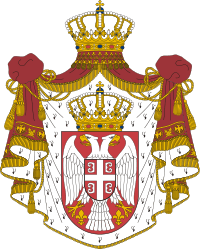
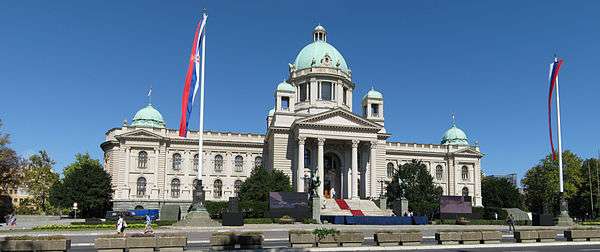
.jpg)
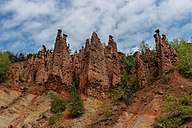
.jpg)
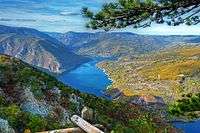
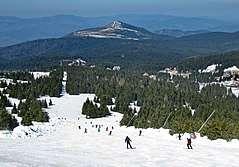
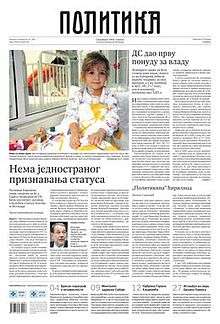
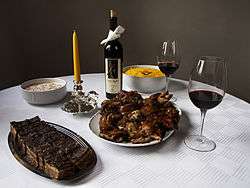
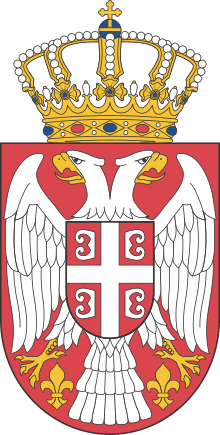
.svg.png)
